

Notes on Videographic Criticism

Volume 4, Issue 3: The Best Video Essays of 2023
Plus, a mix of new videographic publications, cfps, and more.

For the seventh time, the venerable British magazine Sight & Sound has published a survey of the year’s “best” video essays . Curated this year by Irina Trocan, Queline Meadows, and Will Webb, this year’s poll features “48 voters from 17 countries, including academics, critics, online creators and festival curators. Together, their 260 nominations include 181 distinct titles.”
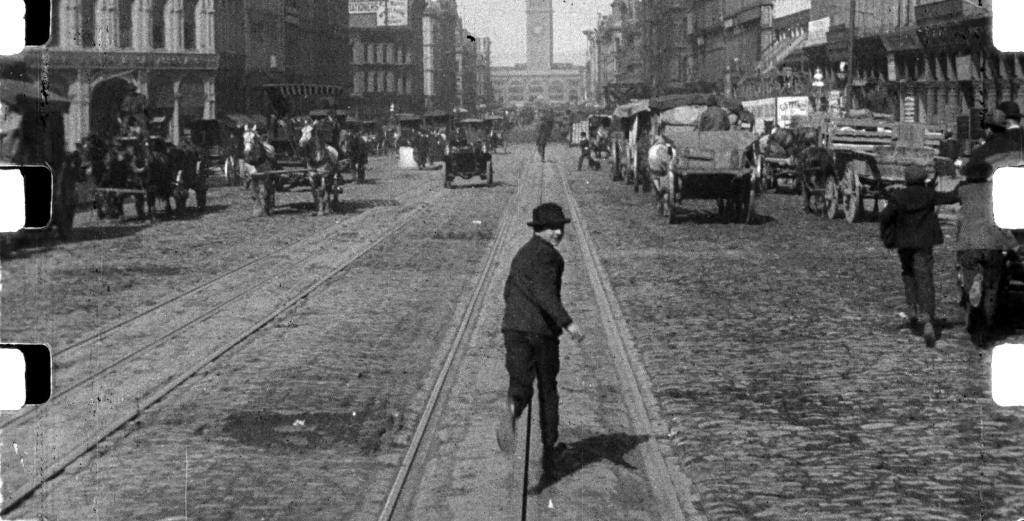
For the fifth time, I sent in ballot, which reads as follows:
Each year, it gets more difficult to be a viewer of video essays; it is a beautiful and frustrating thing. More people are making them. They are longer. They screen at festivals, and in varied corners of the internet. Below are a few of the video essays that have resonated with me this year. Rather than try and explain why I picked them, I will instead attempt to describe something in each work. Here’s hoping it might inspire you to give them all a watch. Joséphine Baker Watches Herself by Terri Francis [3:43] On the left, Joséphine Baker performs in the famous skirt made out of bananas. On the right, a clip from a 1968 CBC interview with Baker. Below, a translation on screen: “No, it’s about work. You have to work hard.” A video essay that grows richer with each rewatch. Apostles of Cinema (Tenzi za sinema) by Cece Mlay, Darragh Amelia, Gertrude Malizana, Jesse Gerard Mpango “I like quality films. And I like difficult films,” says DJ Black. But if it is bad, “I can’t dub it.” [04:51] An incisive documentary about film culture in Tanzania. watch me sleep: self-surveillance and middle-aging queer performance anxiety by Dayna McLeod There’s a moment in the second minute I felt throughout my whole body. A revelation. Void by Kevin Ferguson The persistence of Robert Duvall’s bald head, especially at [00:13] and [04:46]. Why the Internet Loves Buster Keaton by Don McHoull I imagine Don’s masterful montages of the internet’s response to Keaton’s artistry, and also that of Fayard and Harold Nicholas, playing on the wall of a gallery. moving poems: a raisin in the sun (1961) by Desirée de Jesús Water ripples. Sidney Poitier, playing with his lighter, gestures for a drink. His finger points to the text on screen, “in the sun?” Off-screen dialogue plays. [00:26] A harmonious blend of sound, image, and text. Miss Me Yet by Chris Bell Each episode begins with George W. Bush raising his middle finger to the camera, a gesture that becomes more grotesque and poignant the more one watches.
As always, reading the list this year came with a fantastic sense of discovery, and also the occasional, “How did I miss that one?!”, or “That was released this year?!” I look forward to revisiting the list again and again in the coming months and years.
I am equally excited to share a new episode of The Video Essay Podcast, “Curating Sight & Sound 's Best Video Essays of 2023.” In a conversation moderated by Kevin B. Lee, the curators of this year's list discuss the results of the poll, their curatorial strategies, and offer general thoughts on the video essay landscape in 2023.
This episode is the first in an ongoing collaboration between The Video Essay Podcast and Kevin, who, in his role as the Locarno Film Festival Professor for the Future of Cinema at USI University of Lugano, is leading a three-year research project on video essays with Johannes Binotto and Evelyn Kreutzer, funded by the Swiss National Science Foundation.
Thanks for reading Notes on Videographic Criticism! Subscribe for free to receive new posts and support my work.
News & Notes
Have something you would like featured in this section? Email me! willdigravio[at]gmail.com.
Lucy Fife Donaldson, Colleen Laird, Dayna McLeod and Alison Peirse have announced a new videographic initiative, Ways of Doing . From their website :
We are fostering an ethical praxis of audiovisual research, including the modeling of feminist citational practices, collective care, and the creation of an inclusive, videographic community of practitioners. We encourage engagement with the resources we offer here and provide suggestions on citational practices for the classroom and for your own creative practice.
Applications are now open for the 2024 Scholarship in Sound & Image Workshop at Middlebury College! From Jason Mittell:
Join me, Catherine Grant and Dayna McLeod in Middlebury Vermont from June 16-29 to learn how to make videographic work, whether you're new to the form or have experience and want to develop your skills & style.
Applications are due February 12, 2014. For more information on the program, tuition, and beautiful Middlebury, Vermont (yes, I am biased!) click here .
Calls for Video Essays
II International Permanent Seminar Intersecting Perspectives on Spanish Media: Women and Horror, June 13th and 14th, Campus Madrid-Puerta Toledo (Universidad Carlos III de Madrid):
This seminar aims to address the relationship between women and horror in Spanish cinema and TV from various perspectives, with special attention to contemporary works, but without overlooking the influence that past works have had on present views in terms of themes, representation, or circulation. We invite submissions of papers or video essays on the following topics: Horror works directed and/or written by women. Social and aesthetic representation of women in horror films and TV series. Genre hybridity, horror & gender. Horror subgenres (slasher, zombie films, etc.) and gender Female stars & horror. Horror & the representation of LGBTQI+ subjectivities and bodies. Horror, gender & class. Distribution and consumption of Horror Films and its relationship with gender. Connections between Spanish media and other industries with a special focus on Latin America. Deadline for proposals: February 15, 2024. More here .
The Essay Library invites submissions for the collaborative project, “These Video Essays Do Not Exist | An April Fools' Day collaboration.” Learn more here ahead of the March 24, 2024 deadline.
The Jimmy Stewart Museum invites submissions for its Video Essay Showcase. No deadline is given, but works will screen at a virtual symposium in May 2024. Learn more here .
The International Association for Media and Communication Research (IAMCR) calls for academic audio/visual work to be presented at IAMCR 2024, which will be held in Christchurch, New Zealand, from 30 June to 4 July 2024. Learn more here before the February 7, 2024 deadline.
New Publications
Over at RogerEbert.com , a host of writers penned a wonderful tribute to Scout Tafoya, whose ongoing video essay series The Unloved celebrated its tenth anniversary. Read here .
Issue 12 of the journal Tecmerin includes a special section, “Urban Spaces and Cinema. Ibero-American Cities in the Audiovisual Field,” edited by Luis Deltell Escolar and Nadia McGowan. Essays include:
“ Four individuals in São Paulo ” by Luis Deltell Escolar “ A-Ten-Thousand-Legs Madrid ” by Asier Gil Vázquez “ Dispossesssion Through Mortgage Debt in Three Acts ” by Laura Caballero Rabanal “ Realism(s) ” by Sylvia González Rodríguez “The Mistery of Creating: Murcia under Carlos Saura’s gaze” by Daniel Toledo Saura “ Cities of Ibero-America as seen by Artificial Intelligence ” by Nadia McGowan Additional video essays published in the issue: “ Women on the Verge of Financial Crisis ” by Tomer Nechushtan “ Rapuncelia ” by Joseph M. Johnson “ Power and Gardens ” by Nico Carpentier “ ‘Do you really want to have children?’ Off-screen Motherhood in Spanish Dramedies ” by Lorenzo Torres, Mariona Visa, and Mª Isabel Menéndez Two videos published as part of the Student Showcase: “ Los tramposos ” by Pablo Manzano Ben “ La virgen de diciembre ” by Gabriela Verdú Bisbal, Anabel Cobo Vázquez, and Irene Igeño García And four new additions to the Screen Stars Dictionary : “ Aishwarya Rai Bachchan ” by Sureshkumar P. Sekar “ Leonard Bernstein ” by Evelyn Kreutzer “ Robert De Niro ” by Daniel O’Brien “ Shah Rukh Khan ” by Ritika Kaushik “ Tony Leung ” by Jialu Zhu
An exciting new special issue of [in]Transition , curated by Ariel Avissar, who writes:
This is the first of two special issues devoted to videographic pedagogy, highlighting student work. The current issue showcases and reflects on a selection of videos made by students of my own videographic criticism honors course at the Steve Tisch School of Film and Television at Tel Aviv University, between 2020 and 2022.
Watch here .
Be sure to watch the Essay Library Anthology’s sixth volume, “ Becoming Someone Else .”
Back in October, over at Hyperallergic, Dan Schindel put together a list, “ Five Video Essays That Go Beyond the Surface .”
The Autumn 2023 issue of NECSUS , which centers on the theme of “#Cycles,” includes five audiovisual essays:
Cycles of Labour: In the Metaverse, We Will Be Housewives by Veronika Hanáková, Martin Tremčinský, and Jiří Anger Split Screen as Hermeneutic Tool: Recursivity and Crosstalk in Better Call Saul by Nicolás Medina and Miklós Kiss Close Circuit by Tripot I foresee that I’m going to have known it by Vorozheikin Yevhen The Time-Loop as Game Mechanic, Narrative Device and Cycle of Systemic Racism by Daniel O’Brien
The latest issue of Open Screens , the journal of the British Association of Film, Television, & Screen Studies, includes two publications that will be of particular interest to readers of this newsletter:
“ Tennis | House: Medical Imaging as Videographic Criticism ” by Kevin Ferguson “'Enter the Memory': Interactivity, Authorship, and the Empowered Spectator in the Digital Audio-Visual Essays of Chris Marker” by James Michael Slaymaker
SUBSCRIBE TO THE PODCAST: iTunes | Spotify | Anchor
FOLLOW: Twitter | Facebook | Website
Ready for more?

The Best Video Essays of 2022
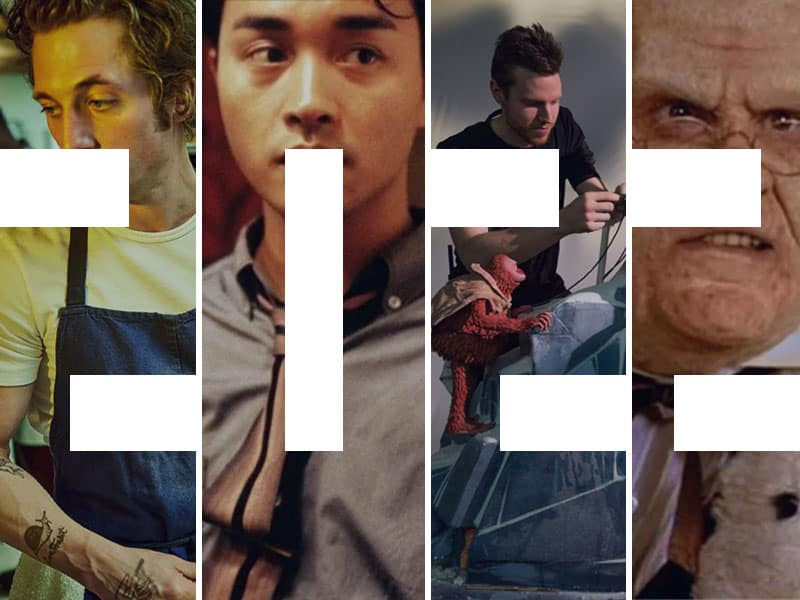
This article is part of our 2022 Rewind . Follow along as we explore the best and most interesting movies, shows, performances, and more from this very strange year. In this entry, we explore the best video essays of 2022.
2022 has, inconceivably, come to an end. And in the spirit of reflection and gratitude, it’s time to appreciate the thing that had our back when times were tough; the thing that helped us wind down after a long day at work; the thing that made that first cup of coffee in the morning go down just a little easier: video essays.
This year, I had the pleasure of once again curating The Queue , a thrice-weekly column dedicated to highlighting short-form video content about films, television, and the craft of visual storytelling. As a result, the focus of the video essays below is movies and TV shows — if you’re wondering why there are no video essays on speed running mechanics or broadway musical drama, that’s why!
There were, it must be said, a heck of a lot of top-shelf video essays this year that fell outside the scope of this list (including, but not limited to, Jacob Geller’s poetic eulogy to sea monsters ; People Make Games’ anthropological exploration of VRChat , and Jenny Nicholson’s sarcastically long portrait of Evermore , the theme park that tried to sue Taylor Swift).
Once again, I had a doozy of a time narrowing down a short list of this year’s selections. So if you could all stop making such good #content, that would be great (just kidding, never stop). I want to sincerely thank all the essayists I’ve covered this year for their hard work. I hope I get to continue seeing you in my feed in 2023 and beyond.
Bergman Island: Art, Love, and the Unbearable Process of Making
French director Mia Hansen-Løve embraces the notion of autobiographical filmmaking. And the video essay above does a beautiful job illustrating how her first English-language film, Bergman Island , draws attention to the process of its own making without sacrificing its own story. I love how this essayist unravels the tapestry of the film’s twisty relationship with metatext with tangible examples and accessible language.
This video essay on the metatextuality of Mia Hansen-Løve’s Bergman Island is by Broey Deschanel a self-described “snob (and YouTuber) whose video essays cover everything from new releases like Licorice Pizza and Euphoria to camp classics like Showgirls . You can subscribe to their YouTube account here and you can follow them on Twitter here .
Realism and Fantastic Cinema
We’re living during an interesting time in visual effects, where more often than not, realism is the goal. The following video essay offers a convincing gospel that preaches a different approach, which proposes that “fantastic cinema” that actively doesn’t chase photorealism or expose its own trickery is different, special, and worth fighting for. If you’ve found other arguments against modern CGI unconvincing — or if your love of practical effects starts and stops with fetishism — I urge you to give this a look.
This video essay on why the pursuit of realism in special effects is hurting the fantasy genre is by APLattanzi , a freelance filmmaker and illustrator who hails from the Philadelphia area. You can subscribe to them on YouTube here . Their essays cover a large swath of topics, from film scores to short films. You can also find them on Letterboxd here .
Gen Z needs more slacker movies
In all fairness, this video essay is preaching to the choir: I’m a huge sucker for slacker movies. And if for whatever reason you’re not, this essayist articulates something that feels True about what the sub-genre offers to the 2020s, an age where we’re increasingly bumping up against the political spirit of fucking off and the price of who can afford to do nothing.
This video essay on why the younger generation (I’m dating myself, whoops!) need some new slacker movies is by Niche Nonsense , a video essay channel that provides, well, just that: niche nonsense. The channel was only created in mid-December of 2021. And you can get in on the ground floor and subscribe here .
Leslie Cheung & Hong Kong LGBT Cinema
Love letters are contagious, and if you’re unfamiliar with Hong Kong star Leslie Cheung , this is a great introduction to one of the greatest LGBTQ+ icons in film history and how he left his impact on the Queer Hong Kong films that came in the wake of his trailblazing.
These videos on the impact of Leslie Cheung on Hong Kong queer cinema is by Accented Cinema , a Canadian-based YouTube video essay series with a focus on Asian cinema. You can subscribe to Accented Cinema for bi-weekly uploads here . You can follow them on Twitter here .
The Secret Ingredient That Makes Raimi’s ‘Spider-Man’ So Great
When people say that modern superhero movies feel soulless, you don’t always get a lot of concrete examples or arguments as to why this is the case aside from a general feeling . Luckily, the above video essay takes the time to nail something specific about why Sam Raimi ‘s Spider-Man trilogy feels so much more sincere and front-the-heart than modern, irony-poisoned Marvel fare.
This video essay on why everyday people make Sam Raimi’s Spider-Man films feel so special is co-written by Patrick (H) Willems and Siddhant Adlakha . You can find their own directorial efforts and their video essays on their channel here . You can also find Willems on Twitter here . And you can find Adlakha on Twitter here .
The Lion King and Disney’s Sequel Curse
Frankly, I didn’t know that I needed an hour-long defence of The Lion King 1 ½ until it was sitting in my YouTube subscriptions. The Disney animated feature-length sequel landscape is, by and large, pretty mid. And while The Lion King 2 is one of the better ones out there, The Lion King 1 ½ is in a class all of its own. If you’re not familiar, the sequel takes place during the events of the first film, but it’s told from the perspective of Timon and Pumba. The following video essay does a stellar job describing why it rules, how it ties into Shakespeare, and why it’s a great example of self-aware filmmaking.
This video on the incredible Disney sequel The Lion King 1 ½ is by Jace, a.k.a BREADSWORD, an LA-based video essayist who specializes in long-form nostalgia-heavy love letters. Impeccably edited and smoother than butter, BREADSWORD essays boast an unparalleled relaxed fit and an expressive narrative tone. Long essays like this take a lot of time to put together, and somehow BREADSWORD makes it all look effortless. You can subscribe to them on YouTube here . And you can follow them on Twitter here .
Twin Peaks Actually, ACTUALLY EXPLAINED (No, But For Real)
This is, quite frankly, one of the most lucid explanations of “why Twin Peaks is the way it is” that I’ve ever seen. Maybe its my small screen ignorance showing, but the idea that TV reflexivity is the key that unlocks Twin Peaks really feels capital-t True. The above is the first of a two-parter, and will hit harder if you’ve seen all three seasons and Fire Walk With Me . I’m also a massive fan of how this essayist choses to frame their work; the Socratic dialogue is alive and well.
This video essay on what Twin Peaks is about, actually, is by Maggie Mae Fish , a Los Angeles-based comedian, actress, and culture critic who releases short films and video essays on her YouTube account . Fish has been featured on College Humor, Screen Junkies, and JASH. She was also a former lead actor and writer at Cracked.com. You can follow Fish on Twitter here .
Nothing But Trouble is a Very Weird Movie
Even if you haven’t had the pleasure of watching Nothing But Trouble with your own two, God-given eyes, you may still have heard rumblings of its notorious status. I appreciate that this video essayist takes the time to give complicated stories — like the making of this movie and why it came to be thought of as a massive bomb — the time they deserve to breathe and speak for themselves.
This video essay on why Nothing But Trouble is good, actually comes to us from In Praise of Shadows , a video essay channel run by Zane Whitener and based in Asheville, North Carolina. The channel focuses on horror, history, and retrospectives. Under their “Anatomy of a Franchise” banner, they break down horror properties including Tremors , The Stepfather , and Re-Animator, in addition to The Hills Have Eyes . You can check out the series’ playlist here . And you can subscribe to the In Praise of Shadows YouTube channel here . And you can follow them on Twitter here .
Why The Bear Hits So Hard
There’s a special bond between cooking and the moving image and Hulu’s The Bear is the latest piece of pop culture to bring the two art forms together. I love how this video essay balances its analysis of the technical and scripted aspects of the show to explain the controlled chaos that defines the feel of the show. Breakdowns like this, that do as much showing as they do telling, are really what the video essay format is all about.
This video essay on the appeal of The Bear is by Virginia-based filmmaker and video editor Thomas Flight . He runs a YouTube channel under the same name. You can follow Thomas Flight and check out his back catalog of video essays on YouTube here . You can follow him on Twitter here .
Under The Skin | Audiovisual Alienation
While I do think that all movies partake in non-verbal storytelling (they are moving pictures, after all), I do think some films are more non-verbal than others. This isn’t to say that these films aren’t about anything or that, more disparagingly, they are “just vibes” (yeesh). Case in point: this thoughtful analysis of Under the Skin , a film that uses non-verbal storytelling to put us in the shoes of an alien visitor trying to make sense of the confusing, predatory, and often beautiful human world.
This video essay on how Under the Skin uses non-verbal storytelling to explore the question of what it means to be human is by Spikima Movies , a Korean-Canadian who’s been dropping gems on YouTube since 2019. You can subscribe to Spikima’s channel for more incredible essays here . And you can follow them on Letterboxd here .
How a 10-year-old girl wrote Japan’s most insane horror film
Just when I thought that House was starting to slip into that special category of movies that have been “talked to death,” someone goes ahead and makes a video essay like this. I adore the messy human stories behind canonized films. And the way that this video essayist describes the father-daughter relationship behind the deeply personal making of House is impeccable, even if you’re already familiar with the general beats.
This video essay on the uncanny origins of the 1977 horror film House is by k aptainkristian, a YouTube-based video essay channel that peddles visual love letters to filmmakers, musicians, and syndicated cartoons. The account is run by Kristian T. Williams , whom you can follow on Twitter here . You can subscribe to kaptainkristian, and check out their back catalog on YouTube here .
Studio LAIKA and the Ghosts of Invisible Labor
Given that conversations on labor and animation are becoming more and more prescient and pointed, this video essay feels like a must-watch. This essayist’s analysis is deeply insightful, compelling, and well-argued. The idea that animators on Laika films are in-universe Lovecraftian gods tickles my brain something fierce.
This video essay on the self-reflexive industrial allegory of Laika studios is written and directed by Mihaela Mihailova . It is produced by Alla Gadassik and edited by Gil Goletski, with Jacqueline Turner providing the narration. The end of the video credits the Vancouver-based Emily Carr University of Art and Design for support. Mihailova is an Assistant Professor in the School of Cinema at San Francisco State University. She is the editor of the essay collection Coraline: A Closer Look at Studio LAIKA’s Stop-Motion Witchcraft (Bloomsbury, 2021)
Why This 1950s Studio Made Movies Backwards
We love a gimmick. And we especially love a gimmick that produces some wildly kick-ass movie posters. This video essay offers a lucid explanation of how AIP cracked the code for making B-Movies: poster first, movie later. Has this principle of making a film from a marketing perspective mutated into something more insidious over time? Yep. Will that make me any less charmed by exploitation cinema? Nope. Look, someone had to make the movies that play at the drive-in while teens suck face in the back of their parents’ Cadillac.
This video on how American International Pictures marketed their films backward is by Andrew Saladino , who runs the Texas-based Royal Ocean Film Society . You can browse their back catalog of videos on their Vimeo account here . If Vimeo isn’t your speed, you can give them a follow on YouTube here .
Why Did Spaghetti Westerns Look Like That?
On the one hand, this is something of a biased pick because I eat Spaghetti Westerns for breakfast, lunch, and dinner. On the other hand, this video essay does a really solid job honing in on one specific aspect of the sub-genre and asking: why? I love laser-focused topics like this, and the fact that it’s about one of the most iconic shot types in genre cinema is just icing on the cake.
This video essay on Sergio Leone’s filmography and how he perfected the use of the close-up shot is by Adam Tinius , who runs the YouTube channel Entertain the Elk . They are based in Pasadena, California. You can follow them on YouTube here . And you can follow them on Twitter here .
The Catharsis of Body Horror
Frankly, the fact that this video essay managed to stay online for as long as it has (thus far) without getting sent back to the shadow realm by YouTube’s AI censor bots is a straight-up miracle. Luckily, as of writing this, the essay is still live and absolutely worth your time, especially if you’re the kind of person who doesn’t vibe with body horror. There’s no shame in having likes and dislikes. But this essay very clearly articulates why body horror is a lot more than the sum of its goo-covered, fleshy parts.
This video essay on the catharsis themes of body horror is by Yhara Zayd . They provide insightful deep dives on young adult content from Skins to My Best Friend’s Wedding . You can check out more of their content and subscribe to their channel on YouTube here . If you like their stuff and you want to support them, you can check out their Patreon here .
Related Topics: 2022 Rewind , The Queue

Recommended Reading
Anatomy of a suspense scene: alfred hitchcock’s 4-part formula, how a24 revived studio loyalty, can we have more solarpunk movies, please, why “day for night” is so hard to pull off.
Level Up Your Life
Subscribe to our newsletter!
Now you can get the top stories from Lifehacker delivered to your inbox. Enter your email below.
By subscribing you agree to our Terms of Use and Privacy Policy.
10 of the Most Niche YouTube Video Essays You Absolutely Need to Watch

The genre of YouTube video essays is more interesting than it sounds. Sure, any piece of video content that advances a central thesis could be considered a “video essay.” But there are key components of video essays that elevate the genre into so much more than simply a YouTube version of a written article. Over the past few years, the term “YouTube video essay” has grown to evoke connotations of niche fascination and discovery. For creators, the field is highly competitive with strong personalities trying to get eyes on extremely in-depth analysis of a wide range of topics. The “niche” factor is especially important here. Ultimately, the hallmark of a good video essay is its ability to captivate you into watching hours of content about a subject matter you would have never expected to care about in the first place. Scary? Maybe. Fun? Definitely.
Whether you’re sceptical about the power of video essays, or you’re an existing fan looking for your next niche obsession, I’ve rounded up some of my personal favourite YouTube video essays for you to lean in and watch. This is not a comprehensive list by any means, and it largely reflects what the algorithm thinks (knows) I personally want to watch.
Other factors that influenced my selection process: The video essays needed to have a strong, surprising thesis — something other than a creator saying “ this thing good ” or “ this thing bad. ” These videos also stood out to me due to their sheer amount of thorough, hard-hitting evidence, as well as the dedication on the behalf of the YouTubers who chose to share with us hours upon hours of research into these topics.
And yes, I have watched all the hours of content featured here. I’m a professional.
Disney’s FastPass: A Complicated History
Let’s start strong with a documentary so premium, I can’t believe it’s free. Multiple articles and reviews have been dedicated to Defunctland’s video series about, well, waiting in line. I know what you’re thinking — the only thing that sounds more boring than waiting in line is watching a video about waiting in line. But Defunctland’s investigation into the history of Disneyland’s FastPass system has so much more to offer.
Class warfare. Human behaviour. The perils of capitalism. One commenter under the video captures it well by writing “oddly informative and vaguely terrifying.” Since its launch in 2017, Kevin Perjurer’s entire Defunctland YouTube channel has become a leading voice in extremely thorough video essays. The FastPass analysis is one of the most rewarding of all of Defunctland’s in-depth amusement park coverage.
I won’t spoil it here, but the best part of the video is hands-down when Perjurer reveals an animated simulation of the theme park experience to test out how various line-reservation systems work. Again, no spoilers, but get ready for a wildly satisfying “gotcha” moment.
Personally, I’ve never had any interest one way or another about Disney-affiliated theme parks. I’ve never been, and I never planned on going. That’s the main reason I’m selling you on this video essay right off the bat. Defunctland is a perfect example of how the genre of video essays has such a high bar for investigative reporting, shocking analysis, and an ability to suck you in to a topic you never thought you’d care about.
Watch time : 1:42:59 (like a proper feature documentary)
THE Vampire Diaries Video
No list of video essays can get very far without including Jenny Nicholson , a true titan of the genre. Or, as one commenter puts it, “The power of Jenny Nicholson: getting me to watch an almost three hour long video about something I don’t care about.” I struggled to pick which of her videos to feature here, but at over seven million views, “THE Vampire Diaries Video” might just be Nicholson’s magnum opus. Once you break out the red string on a cork board, it’s safe to say that you’re in magnum opus territory.
I haven’t ever seen an episode of CW’s The Vampire Diaries , but since this video essay captivated me, I can safely say that I’m an expert on the show. Nicholson’s reputation as a knowledgeable, passionate, funny YouTuber is well-earned. She’s a proper geek, and watching her cultural analyses feel like I’m nerding out with one of my smartest friends. If you really don’t think The Vampire Diaries investigation is for you (and I argue that it’s for everyone), I recommend “ A needlessly thorough roast of Dear Evan Hansen ” instead.
Watch time : 2:33:19
In Search Of A Flat Earth
Did you think you could get through a YouTube video round-up without single mention of Flat Earthers? Wishful thinking.
“In Search of Flat Earth” is a beautiful, thoughtful video essay slash feature-length documentary. Don’t go into this video if you’re looking to bash and ridicule flat earth conspiracy theorists. Instead, Olson’s core argument takes a somewhat sympathetic gaze to the fact that Flat Earthers cannot be “reasoned” out of their beliefs with “science” or “evidence.” Plus, this video has a satisfying second-act plot twist. As Olson points out, “In Search of Flat Earth” could have an alternative clickbait title of “The Twist at 37 Minutes Will Make You Believe We Live In Hell.” Over the years, Dan Olson of Folding Ideas has helped to popularise the entire video essay genre, and this one just might be his masterpiece.
Watch time : 1:16:16
The Rise and Fall of Teen Dystopias
Sarah Z is your go-to Gen Z cultural critic and explainer. The YouTuber brings her knack for loving-yet-shrewd analysis to dig into fandom culture, the YA book industry, and why the teen dystopia got beaten into the ground.
I’ve found that one of the most reliable video essay formulas is some version of “what went wrong with [incredibly popular cultural moment].” In the case of teen dystopias, it’s a fascinating take on how a generation of teen girls were drawn to bad arse, anti-establishment heroines, only to watch those types of characters get mass produced and diluted into mockery. But maybe I’m biased here; as the exact demographic targeted by the peak of The Hunger Games, Twilight, and Divergent, this cultural debrief speaks to my soul.
Watch time : 1:22:41
A Buffet of Black Food History
Food is an effective way to combine economic, cultural, and social histories–and Black American food history is an especially rich one. Food resonates with people, allowing us to connect with the past in a much more real way than if we were memorising dates and locations from a textbook. Historian Elexius Jionde of Intelexual Media is a pro at taking what could be a standard history lesson and turning it into an interesting journey full of crazy characters and tidbits.
Most of the comments beneath the video are complaints that the video deserves to be so much longer. It’s jam-packed with surprising facts, fun asides, and, of course, tantalising descriptions of the food at hand. Jionde even warns you right at the top: “Turn this video off right now if you’re hungry.”
Watch time : 22:39
The reign of the Slim-Thick Influencer
At this point, I’m assuming you know what a BBL is. Even if you aren’t familiar with the term (Brazilian butt lifts, FYI), then you’ve still probably observed the trend. Before big butts, it was thigh gaps. The pendulum swing of trending body types is nothing new. Curves are in, curves are out, thick thighs save lives, “skinny fat” is bad, and now, “slim thick” looms large. How do different body types fall in and out of fashion, and what effect does this have on the people living in those bodies?
Creator Khadija Mbowe identifies and analyses a lot of the issues with how women’s bodies (especially Black women’s) are commodified, without ever blaming the bodies that are under fire. Mbowe handles the topic with grace and humour, even when discussing how deeply personal it is to them. If you’ve ever found yourself staring at a photo of an Instagram influencer, please do yourself a favour and watch this video essay.
Watch time : 54:18
Flight of the Navigator
Once again: I have been sucked into a video about a film that I have never seen and probably never will. Captain Disillusion, whose real name is Alan Melikdjanian, is another giant of the video essay genre, posting videos to a not-too-shabby audience of 2.29 million subscribers. Most of Captain Dissilision’s videos that I’d seen before this were of the creator debunking viral videos, exposing how certain visual effects were “obviously” faked. In this video, he turns his eye for debunking special effects not to viral videos, but to the 1986 Disney sci-fi adventure Flight of the Navigator.
This behind-the-scenes analysis of the Disney film is incredibly informative, tackling every instance when someone might ask, “ Hey, how did they manage to film that? ” It also touches upon the history of the special effects industry, something that deserves a little extra appreciation as CGI takes over every corner of movie-making.
Watch time : 41:28
The Failure of Victorious
YouTuber Quinton Reviews is dedicated to his craft, and I thank him for it. As you’ve certainly caught on to by now, you truly do not need to know anything about the show Victorious to enjoy an hours-long video essay that digs into it. What makes this video stand out is the sheer amount of content that this YouTuber both consumed and then created for us. Part of the video length — a whopping five hours — is due to the fact that every single episode of the Nickelodeon show is dissected. Another reason for the length is all the care that Quinton Reviews puts into providing context. And the context is what made me stick around: the failures of TV networks, the psychological dangers of working as child stars, and the questionable adult jokes that were broadcast to young audiences…if you’re at all interested in tainting your memory of hit Nickelodeon shows, this video is for you.
Watch time : 5:34:58 ( And that’s just part one. Strap in! )
Why Anime is for Black People
In this video Travis goes through the history of the “hip hop x anime” phenomenon, in which East Asian media permeates Black culture (and vice versa, as he hints at near the end). Although I am (1) not Black and (2) not an avid anime fan, I first clicked on this video because I’m a fan of comedian and writer Yedoye Travis. And yet — big shocker — I was immediately engrossed with the subject matter, despite having no context heading into it. Once you finish watching this video, be sure to check out Megan Thee Stallion’s interview about her connection to anime .
I haven’t run this part by my editor yet, but now would be a prime time to plug Lifehacker Editor-in-Chief Jordan Calhoun’s book, Piccolo Is Black: A Memoir of Race, Religion, and Pop Culture . Just saying.
Watch time : 18:34 (basically nothing in the world of video essays, especially compared to the five hours of Victorious content I binged earlier)
Efficiency in Comedy: The Office vs. Friends
I’m rounding out this list on a note of personal sentimentality. This is one of the first video essays that got me hooked on the format, mostly because I had followed creator Drew Gooden to YouTube after his stardom on Vine (RIP). This video is one of his most popular, combining comedy and maths to pit two of the most popular sitcoms of all time in a joke-for-joke battle.
Gooden in particular stands out as someone who excels as both an earnest comic and a thoughtful critic of comedy. I appreciate his perspective as someone who knows what it’s like to work for a laugh and wants to get to the bottom of why something is or isn’t funny. This isn’t even one of Gooden’s best videos (I actually think his take on the parallels between Community and Arrested Development has a much stronger argument), but it’s a great example of the sort of perspective best situated to make video essays in the first place. Because what makes all these video essays so compelling is often the personality behind the argument. These aren’t investigative journalists or professional critics. They’re YouTubers. Really smart YouTubers, but still: These videos are born out of everyday people who simply have something to say.
I believe the modern YouTube video essay is uniquely situated to put cultural critique back into the hands of the average consumer — but only if that consumer is willing to put in the work to become a creator themselves.
Leave a Reply Cancel reply
You must be logged in to post a comment.

What is a Video Essay? The Art of the Video Analysis Essay
I n the era of the internet and Youtube, the video essay has become an increasingly popular means of expressing ideas and concepts. However, there is a bit of an enigma behind the construction of the video essay largely due to the vagueness of the term.
What defines a video analysis essay? What is a video essay supposed to be about? In this article, we’ll take a look at the foundation of these videos and the various ways writers and editors use them creatively. Let’s dive in.
Watch: Our Best Film Video Essays of the Year
Subscribe for more filmmaking videos like this.
What is a video essay?
First, let’s define video essay.
There is narrative film, documentary film, short films, and then there is the video essay. What is its role within the realm of visual media? Let’s begin with the video essay definition.
VIDEO ESSAY DEFINITION
A video essay is a video that analyzes a specific topic, theme, person or thesis. Because video essays are a rather new form, they can be difficult to define, but recognizable nonetheless. To put it simply, they are essays in video form that aim to persuade, educate, or critique.
These essays have become increasingly popular within the era of Youtube and with many creatives writing video essays on topics such as politics, music, film, and pop culture.
What is a video essay used for?
- To persuade an audience of a thesis
- To educate on a specific subject
- To analyze and/or critique
What is a video essay based on?
Establish a thesis.
Video analysis essays lack distinguished boundaries since there are countless topics a video essayist can tackle. Most essays, however, begin with a thesis.
How Christopher Nolan Elevates the Movie Montage • Video Analysis Essays
Good essays often have a point to make. This point, or thesis, should be at the heart of every video analysis essay and is what binds the video together.
Related Posts
- Stanley Kubrick Directing Style Explained →
- A Filmmaker’s Guide to Nolan’s Directing Style →
- How to Write a Voice Over Montage in a Script →
interviews in video essay
Utilize interviews.
A key determinant for the structure of an essay is the source of the ideas. A common source for this are interviews from experts in the field. These interviews can be cut and rearranged to support a thesis.
Roger Deakins on "Learning to Light" • Video Analysis Essays
Utilizing first hand interviews is a great way to utilize ethos into the rhetoric of a video. However, it can be limiting since you are given a limited amount to work with. Voice over scripts, however, can give you the room to say anything.
How to create the best video essays on Youtube
Write voice over scripts.
Voice over (VO) scripts allow video essayists to write out exactly what they want to say. This is one of the most common ways to structure a video analysis essay since it gives more freedom to the writer. It is also a great technique to use when taking on large topics.
In this video, it would have been difficult to explain every type of camera lens by cutting sound bites from interviews of filmmakers. A voice over script, on the other hand, allowed us to communicate information directly when and where we wanted to.
Ultimate Guide to Camera Lenses • Video essay examples
Some of the most famous video essayists like Every Frame a Painting and Nerdwriter1 utilize voice over to capitalize on their strength in writing video analysis essays. However, if you’re more of an editor than a writer, the next type of essay will be more up your alley.
Video analysis essay without a script
Edit a supercut.
Rather than leaning on interview sound bites or voice over, the supercut video depends more on editing. You might be thinking “What is a video essay without writing?” The beauty of the video essay is that the writing can be done throughout the editing. Supercuts create arguments or themes visually through specific sequences.
Another one of the great video essay channels, Screen Junkies, put together a supercut of the last decade in cinema. The video could be called a portrait of the last decade in cinema.
2010 - 2019: A Decade In Film • Best videos on Youtube
This video is rather general as it visually establishes the theme of art during a general time period. Other essays can be much more specific.
Critical essays
Video essays are a uniquely effective means of creating an argument. This is especially true in critical essays. This type of video critiques the facets of a specific topic.
In this video, by one of the best video essay channels, Every Frame a Painting, the topic of the film score is analyzed and critiqued — specifically temp film score.
Every Frame a Painting Marvel Symphonic Universe • Essay examples
Of course, not all essays critique the work of artists. Persuasion of an opinion is only one way to use the video form. Another popular use is to educate.
- The Different Types of Camera Lenses →
- Write and Create Professionally Formatted Screenplays →
- How to Create Unforgettable Film Moments with Music →
Video analysis essay
Visual analysis.
One of the biggest advantages that video analysis essays have over traditional, written essays is the use of visuals. The use of visuals has allowed video essayists to display the subject or work that they are analyzing. It has also allowed them to be more specific with what they are analyzing. Writing video essays entails structuring both words and visuals.
Take this video on There Will Be Blood for example. In a traditional, written essay, the writer would have had to first explain what occurs in the film then make their analysis and repeat.
This can be extremely inefficient and redundant. By analyzing the scene through a video, the points and lessons are much more clear and efficient.
There Will Be Blood • Subscribe on YouTube
Through these video analysis essays, the scene of a film becomes support for a claim rather than the topic of the essay.
Dissect an artist
Essays that focus on analysis do not always focus on a work of art. Oftentimes, they focus on the artist themself. In this type of essay, a thesis is typically made about an artist’s style or approach. The work of that artist is then used to support this thesis.
Nerdwriter1, one of the best video essays on Youtube, creates this type to analyze filmmakers, actors, photographers or in this case, iconic painters.
Caravaggio: Master Of Light • Best video essays on YouTube
In the world of film, the artist video analysis essay tends to cover auteur filmmakers. Auteur filmmakers tend to have distinct styles and repetitive techniques that many filmmakers learn from and use in their own work.
Stanley Kubrick is perhaps the most notable example. In this video, we analyze Kubrick’s best films and the techniques he uses that make so many of us drawn to his films.
Why We're Obsessed with Stanley Kubrick Movies • Video essay examples
Critical essays and analytical essays choose to focus on a piece of work or an artist. Essays that aim to educate, however, draw on various sources to teach technique and the purpose behind those techniques.
What is a video essay written about?
Historical analysis.
Another popular type of essay is historical analysis. Video analysis essays are a great medium to analyze the history of a specific topic. They are an opportunity for essayists to share their research as well as their opinion on history.
Our video on aspect ratio , for example, analyzes how aspect ratios began in cinema and how they continue to evolve. We also make and support the claim that the 2:1 aspect ratio is becoming increasingly popular among filmmakers.
Why More Directors are Switching to 18:9 • Video analysis essay
Analyzing the work of great artists inherently yields a lesson to be learned. Some essays teach more directly.
- Types of Camera Movements in Film Explained →
- What is Aspect Ratio? A Formula for Framing Success →
- Visualize your scenes with intuitive online shotlist software →
Writing video essays about technique
Teach technique.
Educational essays designed to teach are typically more direct. They tend to be more valuable for those looking to create art rather than solely analyze it.
In this video, we explain every type of camera movement and the storytelling value of each. Educational essays must be based on research, evidence, and facts rather than opinion.
Ultimate Guide to Camera Movement • Best video essays on YouTube
As you can see, there are many reasons why the video essay has become an increasingly popular means of communicating information. Its ability to use both sound and picture makes it efficient and effective. It also draws on the language of filmmaking to express ideas through editing. But it also gives writers the creative freedom they love.
Writing video essays is a new art form that many channels have set high standards for. What is a video essay supposed to be about? That’s up to you.
Organize Post Production Workflow
The quality of an essay largely depends on the quality of the edit. If editing is not your strong suit, check out our next article. We dive into tips and techniques that will help you organize your Post-Production workflow to edit like a pro.
Up Next: Post Production →
Showcase your vision with elegant shot lists and storyboards..
Create robust and customizable shot lists. Upload images to make storyboards and slideshows.
Learn More ➜
- Pricing & Plans
- Product Updates
- Featured On
- StudioBinder Partners
- The Ultimate Guide to Call Sheets (with FREE Call Sheet Template)
- How to Break Down a Script (with FREE Script Breakdown Sheet)
- The Only Shot List Template You Need — with Free Download
- Managing Your Film Budget Cashflow & PO Log (Free Template)
- A Better Film Crew List Template Booking Sheet
- Best Storyboard Softwares (with free Storyboard Templates)
- Movie Magic Scheduling
- Gorilla Software
- Storyboard That
A visual medium requires visual methods. Master the art of visual storytelling with our FREE video series on directing and filmmaking techniques.
We’re in a golden age of TV writing and development. More and more people are flocking to the small screen to find daily entertainment. So how can you break put from the pack and get your idea onto the small screen? We’re here to help.
- Making It: From Pre-Production to Screen
- Is Film School Worth It — Why You Should or Shouldn’t Go
- How to Write a Poem — A Step-by-Step Guide
- What is a Character Flaw — And Why Writers Love Them
- How to Become a Movie Critic — Career Tips Explained
- What is an Indie Film — Definition & History Explained
- 100 Facebook
- 0 Pinterest
The Best Video Essay Channels, Ranked
Cinephiles and film buffs owe it to themselves to check out these YouTube channels which brilliantly analyze and explain movies using video essays.
If you’re a die-hard movie fan, you don’t have to be a hardcore collector to know that you can find a lot of your special features free on YouTube – from movie trailers and top-ten lists to reaction videos and cast-and-crew interviews. But the crème de la crème for any budding cinephile is YouTube ’s subculture of video essayists.
The best of these content creators, particularly those focused on dissecting and analyzing film and television, give viewers a lot of food for thought, making them consider things they hadn’t before, even when it comes to movies they have watched 100 times. There is an embarrassment of content out there, but this article seeks to separate the wheat from the chaff – we are recommending only the channels with the best, most refreshing, and most original analysis. If you're a film lover or budding buff, you owe it to yourself to check out these great video essay channels.
What’s So Great About That?
UK creator and pop-culture academic Grace Lee makes video essays examining themes and form in both horror and animated media; she has an affinity for the deeper, more unexpected thoughts evoked by her favorite genres. Whereas many content creators are quippy or sarcastic, Lee’s voiceover narrative approach is one of measured thoughtfulness.
Related: Explained: How Twin Peaks Changed Television
While her output as What's So Great About That? is not as large as some other creators on this list, that is far from a bad thing as Lee seems to focus more on quality than quantity. Each video discusses fairly narrow topics within a given property – examples include the “treachery of language” in the work of David Lynch or the concept of the “unnatural” in the original Evil Dead film.
You might mistake Canadian vlogger Sarah Z (pronounced “Zed”) for your best friend. She sits on the couch with a cup of coffee and speaks directly to you, a monologuist spending hours on end about all of her opinions, from toxic fandoms to true-crime documentaries.
But these monologues are not the boring, meaningless yarns that you might expect. Rather, Sarah’s channel is an ever-deepening trove of incisive and engaging media analysis encased in a shell of light and fluffy entertainment. The whole thing is driven by Sarah’s palpable excitement and enthusiasm for the topics she is covering, and a penchant for long, detailed videos that are extensively researched. Some videos will even stretch far beyond the one-hour mark, including a 90-minute video on geek culture and a full two hours on Dear Evan Hansen .
Another Canadian creator steps up to the plate in the form of Sage Hyden , a fantasy novelist whose essay channel Just Write seems particularly preoccupied with film’s place in the cultural conversation. In particular, Hyden is fascinated with the messages that movies send us, what they are trying to communicate (consciously or subconsciously), and how they shape our perceptions and prejudices.
For topics that can sometimes land on the serious side, Hyden’s tone and writing style are conversational and often funny, and his insights are fairly eye-opening. Topics include Willy Wonka and its relationship to misconceptions about poverty, the importance of the original Mulan film, and the cinematic lineage of the modern murder mystery Knives Out .
If you consider yourself an outsider or find yourself disagreeing with most of your friends on their favorite movies, you might find a mutual kinship with creator Yhara Zayd , whose videos examine film and television through lenses both personal and political. Zayd’s is not the kind of detached analysis you can expect from many YouTubers; rather, though she is very well-researched, she is also full of unapologetic hot takes, and her videos are brimming with the caustic personality of a modern-day Pauline Kael.
Related: These Are the Best Marilyn Monroe Movies
In some ways, Zayd has crafted the perfect synergy between the highly-opinionated critic and the relentless deconstructionist, enthusiastically dissecting and questioning the images and media we regularly consume. She also has a distinct knack for self-awareness, gazing inward as she gazes outward, a quality which separates her content from that of many of her peers. Zayd covers such divergent subjects as the commodification of the great Marilyn Monroe, reflections of housing discrimination in 1980s horror films , and the under-appreciated legacy of Not Another Teen Movie .
For something a little less personal but no less fascinating, it is worth checking out the prolific Susannah McCullough and her channel The Take . McCullough and her extraordinary team make what are probably the best “Explained” videos you’ll be able to find, along with character breakdowns, deconstructions of tropes, and the lessons movies can teach us. They’ve got videos that deconstruct and explain Donnie Darko , The Sopranos , Get Out , and many, many more. They’ve also nerded out with full series on different franchises, including detailed character analyses in shows such as Friends and Breaking Bad .
The writing is smart but accessible, and the arguments are utterly convincing. The videos themselves are breezily edited and full of poppy visuals. The channel also covers many, many genres and types of movies, so you are sure to find something on a movie or TV show you love. The Take offers incisive film analysis in a context that is fun and completely unpretentious.
Maggie Mae Fish
Decadent, performance-driven vlogs like ContraPoints and Philosophy Tube are all the rage these days, and film buffs finally have their own version in the form of Maggie Mae Fish . Ms. Fish is a singular, idiosyncratic voice who pivots wildly from dedicated film scholar to sketch-comedy caricature and back again. She typically sits center-frame in a variety of ornately designed sets, dressed in colorful outfits, while she patiently spoons out detailed, thoughtful analysis over the course of long videos.
For any video-essay enthusiast, Fish is the real deal – wickedly entertaining, subversive, accessible, and always thought-provoking. Her recent two-video series on Twin Peaks is catnip for any fans seeking a new perspective on the show – and an excellent dressing-down of Twin Perfect’s infamous 4.5-hour breakdown. She also deconstructs auteur theory through the works of David Lynch and Stanley Kubrick, and spends two hours discussing Loki ’s debt to Andrei Tarkovsky’s Stalker .
Lindsay Ellis
When it comes to distinct personalities, no vlogger quite matches the likes of the controversial but brilliant Lindsay Ellis . She is a brand unto herself, with an over-the-top, self-deprecating style that can only be described as a hopped-up, sleep-deprived, but no less informed, Adam Curtis. She is often seen drinking wine in her videos, breaking down popular media like Disney movies, musical adaptations, and The Lord of the Rings franchise.
Ellis is one of the originals of the medium, and her work is so singular that her influence has likely extended to all the other creators who occupy this list. Some of her most brilliant work includes “The Whole Plate,” a nine-video series that completely deconstructs the first Transformers film through the lenses of gender, sexuality, and film studies. Her most iconic work includes 40-minute videos ranting about the film adaptations of Rent and The Phantom of the Opera . Due to recent Internet events, she has stopped making videos on YouTube, but her existing videos are still there for all to see and are absolutely worth checking out.
Every Frame A Painting
Sometimes the most obvious answer is still the best one. Taylor Ramos and Tony Zhou’s gorgeous video series Every Frame A Painting is still the benchmark against which all other video essayists are judged. You’ve probably seen their video on Edgar Wright and visual comedy, or the one on silence in the films of Martin Scorsese. The channel has been defunct for several years now, but the content still feels as fresh and original as it did when it was first published.
The topics covered are narrow and unexpected, but they all work extraordinarily well. The writing is tight and evocative, and Zhou’s voice is unforgettably soothing and inviting. The editing is also crisp and beautiful. Ramos and Zhou have become so renowned for their work that they were even invited to contribute to David Fincher’s Voir , a video essay project for Netflix.
- Newsletters
Site search
- Israel-Hamas war
- 2024 election
- Solar eclipse
- Supreme Court
- All explainers
- Future Perfect
Filed under:
The video essay boom
Hour-long YouTube videos are thriving in the TikTok era. Their popularity reflects our desire for more nuanced content online.
Share this story
- Share this on Facebook
- Share this on Twitter
- Share this on Reddit
- Share All sharing options
Share All sharing options for: The video essay boom
/cdn.vox-cdn.com/uploads/chorus_image/image/70598240/GettyImages_1359563328.0.jpg)
The video essay’s reintroduction into my adult life was, like many things, a side effect of the pandemic. On days when I couldn’t bring myself to read recreationally, I tried to unwind after work by watching hours and hours of YouTube.
My pseudo-intellectual superego, however, soon became dissatisfied with the brain-numbing monotony of “day in the life” vlogs, old Bon Appétit test kitchen videos, and makeup tutorials. I wanted content that was entertaining, but simultaneously informational, thoughtful, and analytical. In short, I wanted something that gave the impression that I, the passive viewer, was smart. Enter: the video essay.
Video essays have been around for about a decade, if not more, on YouTube. There is some debate over how the form preceded the platform; some film scholars believe the video essay was born out of and remains heavily influenced by essay films , a type of nonfiction filmmaking. Regardless, YouTube has become the undisputed home of the contemporary video essay. Since 2012, when the platform began to prioritize watch-time over views , the genre flourished. These videos became a significant part of the 2010s YouTube landscape, and were popularized by creators across film, politics, and academic subcultures.
Today, there are video essays devoted to virtually any topic you can think of, ranging anywhere from about 10 minutes to upward of an hour. The video essay has been a means to entertain fan theories , explore the lore of a video game or a historical deep dive , explain or critique a social media trend , or like most written essays, expound upon an argument, hypothesis , or curiosity proposed by the creator.
Some of the best-known video essay creators — Lindsay Ellis, Natalie Wynn of ContraPoints, and Abigail Thorn of PhilosophyTube — are often associated with BreadTube , an umbrella term for a group of left-leaning, long-form YouTubers who provide intellectualized commentary on political and cultural topics.
It’s not an exaggeration to claim that I — and many of my fellow Gen Zers — were raised on video essays, academically and intellectually. They were helpful resources for late-night cramming sessions (thanks Crash Course), and responsible for introducing a generation to first-person commentary on all sorts of cultural and political phenomena. Now, the kids who grew up on this content are producing their own.
“Video essays are a form that has lent itself particularly well to pop culture because of its analytical nature,” Madeline Buxton, the culture and trends manager at YouTube, told me. “We are starting to see more creators using video essays to comment on growing trends across social media. They’re serving as sort of real-time internet historians by helping viewers understand not just what is a trend, but the larger cultural context of something.”
any video that starts with "the rise and fall of" I'm clicking on it no matter the topic — zae | industry plant (@ItsZaeOk) February 23, 2022
A lot has been said about the video essay and its ever-shifting parameters . What does seem newly relevant is how the video essay is becoming repackaged, as long-form video creators find a home on platforms besides YouTube. This has played out concurrently with the pandemic-era shift toward short-form video, with Instagram, Snapchat, and YouTube respectively launching Reels, Spotlight, and Shorts to compete against TikTok.
TikTok’s sudden, unwavering rise has proven the viability of bite-size content, and the app’s addictive nature has spawned fears about young people’s dwindling attention spans. Yet, the prevailing popularity of video essays, from new and old creators alike, suggests otherwise. Audiences have not been deterred from watching lengthy videos, nor has the short-form pivot significantly affected creators and their output. Emerging video essayists aren’t shying away from length or nuance, even while using TikTok or Reels as a supplement to grow their online following.
One can even argue that we are witnessing the video essay’s golden era . Run times are longer than ever, while more and more creators are producing long-form videos. The growth of “creator economy” crowdfunding tools, especially during the pandemic, has allowed video essayists to take longer breaks between uploads while retaining their production quality.
“I do feel some pressure to make my videos longer because my audience continues to ask for it,” said Tiffany Ferguson, a YouTube creator specializing in media criticism and pop culture commentary. “I’ve seen comments, both on my own videos and those I watch, where fans are like, ‘Yes, you’re feeding us,’ when it comes to longer videos, especially the hour to two-hour ones. In a way, the mentality seems to be: The longer the better.”
In a Medium post last April, the blogger A. Khaled remarked that viewers were “willing to indulge user-generated content that is as long as a multi-million dollar cinematic production by a major Hollywood studio” — a notion that seemed improbable just a few years ago, even to the most popular video essayists. To creators, this hunger for well-edited, long-form video is unprecedented and uniquely suitable for pandemic times.
The internet might’ve changed what we pay attention to, but it hasn’t entirely shortened our attention span, argued Jessica Maddox, an assistant professor of digital media technology at the University of Alabama. “It has made us more selective about the things we want to devote our attention to,” she told me. “People are willing to devote time to content they find interesting.”
Every viewer is different, of course. I find that my attention starts to wane around the 20-minute mark if I’m actively watching and doing nothing else — although I will admit to once spending a non-consecutive four hours on an epic Twin Peaks explainer . Last month, the channel Folding Ideas published a two-hour video essay on “the problem with NFTs,” which has garnered more than 6 million views so far.
Hour-plus-long videos can be hits, depending on the creator, the subject matter, the production quality, and the audience base that the content attracts. There will always be an early drop-off point with some viewers, according to Ferguson, who make it about two to five minutes into a video essay. Those numbers don’t often concern her; she trusts that her devoted subscribers will be interested enough to stick around.
“About half of my viewers watch up to the halfway point, and a smaller group finishes the entire video,” Ferguson said. “It’s just how YouTube is. If your video is longer than two minutes, I think you’re going to see that drop-off regardless if it’s for a video that’s 15 or 60 minutes long.”
Some video essayists have experimented with shorter content as a topic testing ground for longer videos or as a discovery tool to reach new audiences, whether it be on the same platform (like Shorts) or an entirely different one (like TikTok).
“Short-form video can expose people to topics or types of content they’re not super familiar with yet,” Maddox said. “Shorts are almost like a sampling of what you can get with long-form content.” The growth of Shorts, according to Buxton of YouTube, has given rise to this class of “hybrid creators,” who alternate between short- and long-form content. They can also be a starting point for new creators, who are not yet comfortable with scripting a 30-minute video.
Queline Meadows, a student in Ithaca College’s screen cultures program, became interested in how young people were using TikTok to casually talk about film, using editing techniques that borrowed heavily from video essays. She created her own YouTube video essay titled “The Rise of Film TikTok” to analyze the phenomenon, and produces both TikTok micro-essays and lengthy videos.
“I think people have a desire to understand things more deeply,” Meadows told me. “Even with TikTok, I find it hard to unfold an argument or explore multiple angles of a subject. Once people get tired of the hot takes, they want to sit with something that’s more nuanced and in-depth.”
@que1ine link in bio #fyp #filmtok #filmtiktok #videoessay ♬ Swing Lynn - Harmless
It’s common for TikTokers to tease a multi-part video to gain followers. Many have attempted to direct viewers to their YouTube channel and other platforms for longer content. On the contrary, it’s in TikTok’s best interests to retain creators — and therefore viewers — on the app. In late February, TikTok announced plans to extend its maximum video length from three minutes to 10 minutes , more than tripling a video’s run-time possibility. This decision arrived months after TikTok’s move last July to start offering three-minute videos .
As TikTok inches into YouTube-length territory, Spotify, too, has introduced video on its platform, while YouTube has similarly signaled an interest in podcasting . In October, Spotify began introducing “video podcasts,” which allows listeners (or rather, viewers) to watch episodes. Users have the option to toggle between actively watching a podcast or traditionally listening to one.
What’s interesting about the video podcast is how Spotify is positioning it as an interchangeable, if not more intimate, alternative to a pure audio podcast. The video essay, then, appears to occupy a middle ground between podcast and traditional video by making use of these key elements. For creators, the boundaries are no longer so easy to define.
“Some video essay subcultures are more visual than others, while others are less so,” said Ferguson, who was approached by Spotify to upload her YouTube video essays onto the platform last year. “I was already in the process of trying to upload just the audio of my old videos since that’s more convenient for people to listen to and save on their podcast app. My reasoning has always been to make my content more accessible.”
To Ferguson, podcasts are a natural byproduct of the video essay. Many viewers are already consuming lengthy videos as ambient entertainment, as content to passively listen to while doing other tasks. The video essay is not a static format, and its development is heavily shaped by platforms, which play a crucial role in algorithmically determining how such content is received and promoted. Some of these changes are reflective of cultural shifts, too.
Maddox, who researches digital culture and media, has a theory that social media discourse is becoming less reactionary. She described it as a “simmering down” of the hot take, which is often associated with cancel culture . These days, more creators are approaching controversy from a removed, secondhand standpoint; they seem less interested in engendering drama for clicks. “People are still providing their opinions, but in conjunction with deep analysis,” Maddox said. “I think it says a lot about the state of the world and what holds people’s attention.”
no u know what i HATE video essay slander......... they r forever gonna be my fav background noise YES i enjoy the lofi nintendo music and YES i want a 3 hour video explaining the importance of the hair color of someone from a show i've never watched — ☻smiley☻ (@smiley_jpeg) January 19, 2022
That’s the power of the video essay. Its basic premise — whether the video is a mini-explainer or explores a 40-minute hypothesis — requires the creator to, at the very least, do their research. This often leads to personal disclaimers and summaries of alternative opinions or perspectives, which is very different from the more self-centered “reaction videos” and “story time” clickbait side of YouTube.
“The things I’m talking about are bigger than me. I recognize the limitations of my own experience,” Ferguson said. “Once I started talking about intersections of race, gender, sexuality — so many experiences that were different from my own — I couldn’t just share my own narrow, straight, white woman perspective. I have to provide context.”
This doesn’t change the solipsistic nature of the internet, but it is a positive gear shift, at least in the realm of social media discourse, that makes being chronically online a little less soul-crushing. The video essay, in a way, encourages us to engage in good faith with ideas that we might not typically entertain or think of ourselves. Video essays can’t solve the many problems of the internet (or the world, for that matter), but they can certainly make learning about them a little more bearable.
Will you support Vox today?
We believe that everyone deserves to understand the world that they live in. That kind of knowledge helps create better citizens, neighbors, friends, parents, and stewards of this planet. Producing deeply researched, explanatory journalism takes resources. You can support this mission by making a financial gift to Vox today. Will you join us?
We accept credit card, Apple Pay, and Google Pay. You can also contribute via
Next Up In Money
Sign up for the newsletter today, explained.
Understand the world with a daily explainer plus the most compelling stories of the day.
Thanks for signing up!
Check your inbox for a welcome email.
Oops. Something went wrong. Please enter a valid email and try again.

Biden might actually do something about ludicrously expensive concert tickets
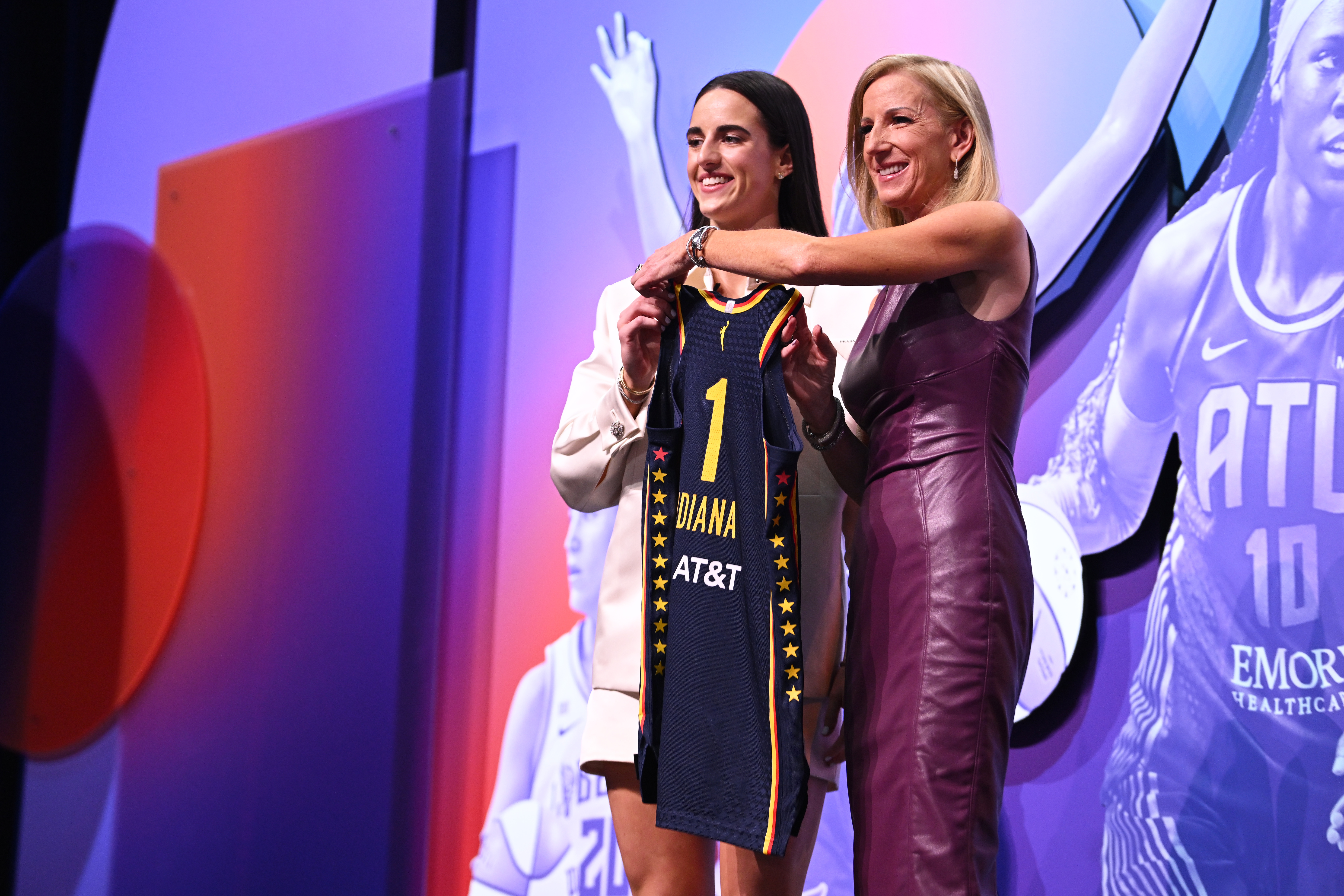
Caitlin Clark’s staggeringly low starting salary, briefly explained
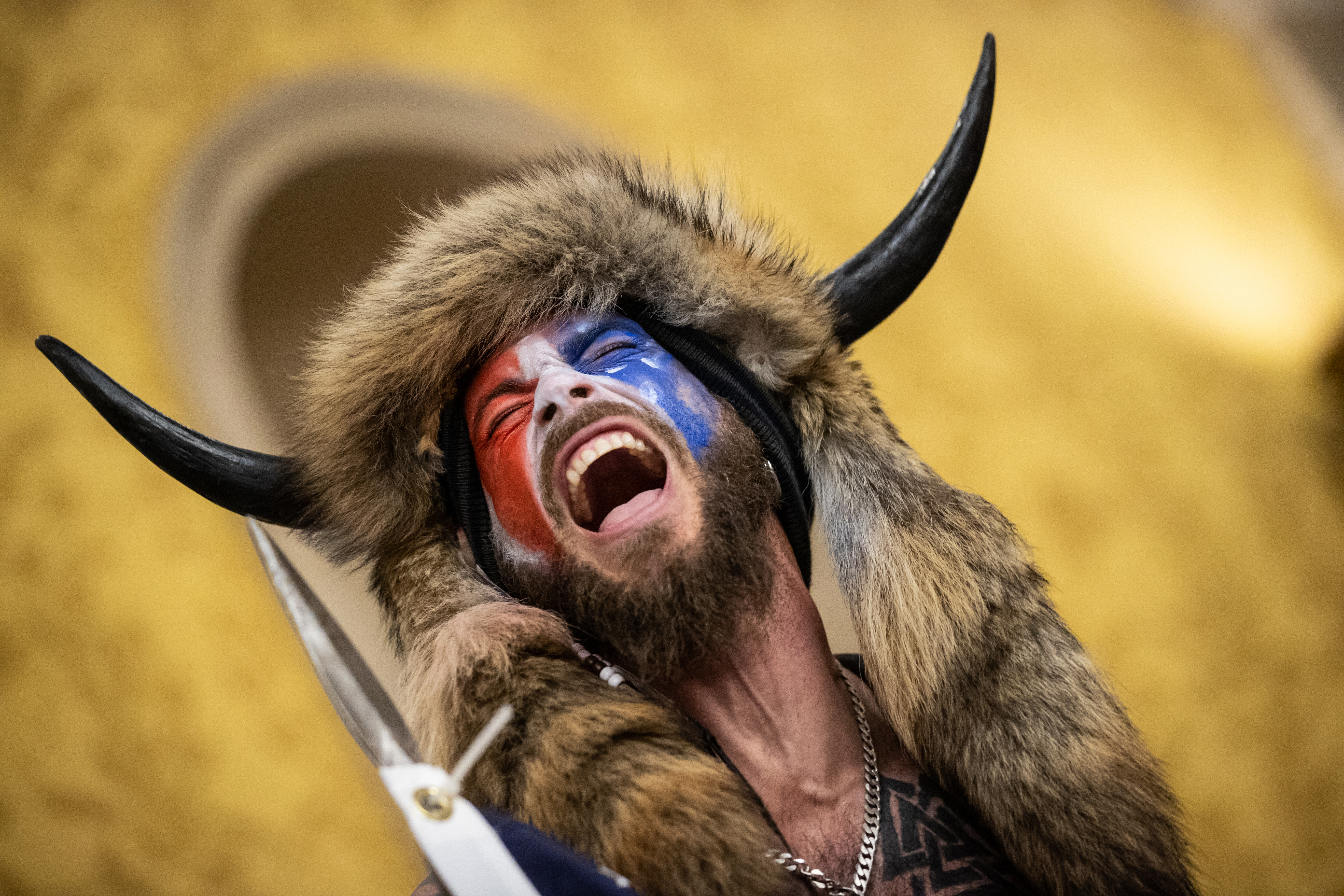
January 6 insurrectionists had a great day in the Supreme Court today
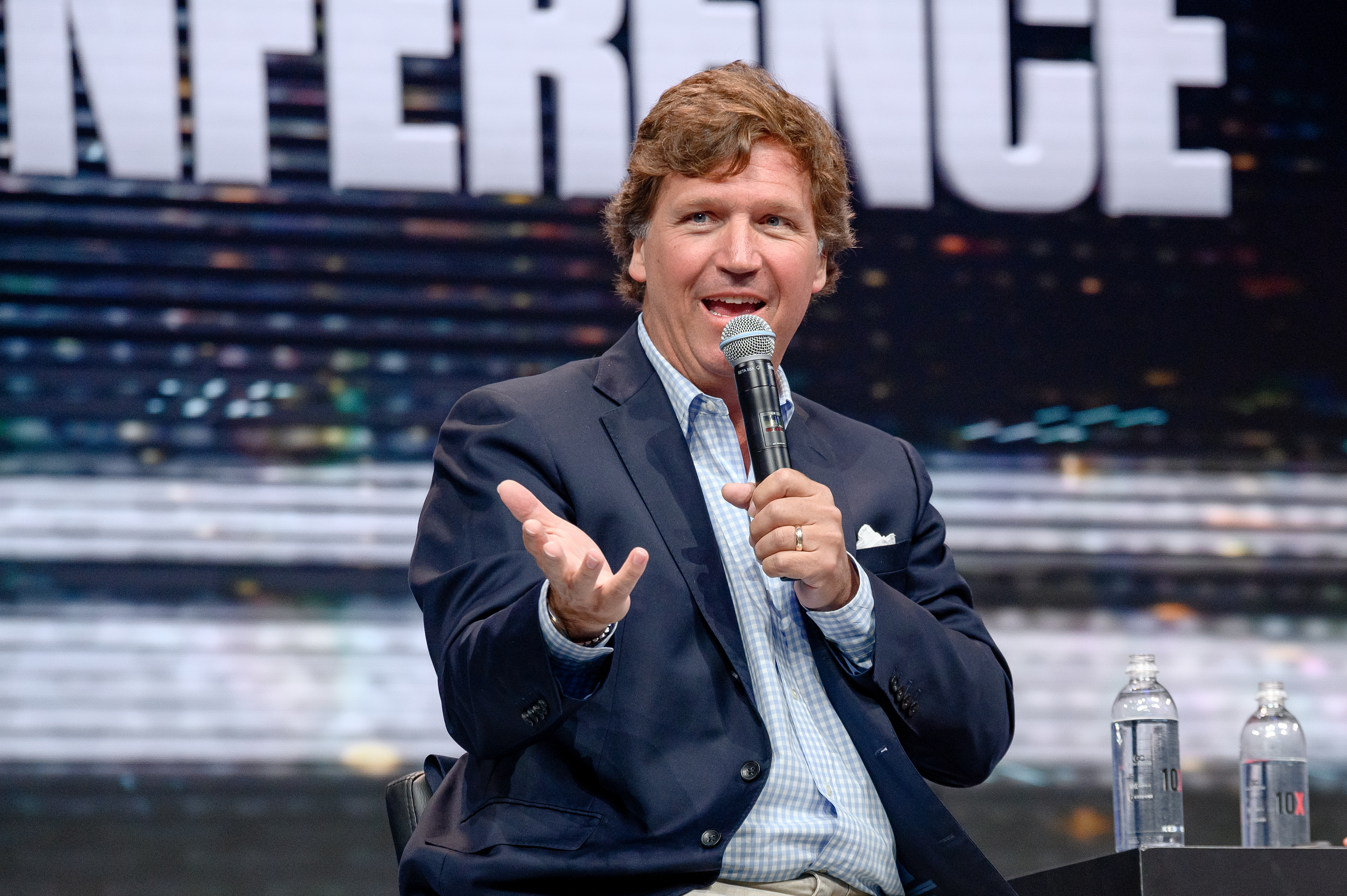
Tucker Carlson went after Israel — and his fellow conservatives are furious

The dairy industry really, really doesn’t want you to say “bird flu in cows”

Why the case at the center of Netflix’s What Jennifer Did isn’t over yet
Welcome to Hyperallergic
Discover artists, learn about new works, and stay connected to the art world with our free newsletters. Register your free account and subscribe to one or more! To see all of our free newsletters, click here.
Newsletters
- Daily The latest stories every weekday morning
- Weekly Editors' picks of the best stories each week
- Opportunities Monthly list of opportunities for artists, and art workers
Privacy Policy
Thank you for registering!
An account was already registered with this email. Please check your inbox for an authentication link.
Hyperallergic
Sensitive to Art & its Discontents
Five Video Essays That Go Beyond the Surface

Support Independent Arts Journalism
As an independent publication, we rely on readers like you to fund our journalism and keep our reporting and criticism free and accessible to all. If you value our coverage and want to support more of it, consider becoming a member today.
Since Hyperallergic first began periodic roundups of video essays in May 2019 , a lot has changed in the field. Some of the video creators featured in the column have ceased working, while many new ones have emerged. The form has become so expansive that it’s spawned its own sub-genres and filmmaking cliques. With so many to sort through, here are some recommendations for the best recent video essays to check out.

“ The History of the Minnesota Vikings” by Dorktown
Even if you don’t care about sports, you should watch the latest from Jon Bois, Alex Rubenstein, and the rest of the crew at Dorktown, a division of the sports website SBNation. A multi-part epic that runs 10 hours in total might seem daunting, but don’t let that dissuade you. Hyperallergic has previously delved into what makes Bois so fascinating as a filmmaker , and he’s only refined his technique and deepened his storytelling sophistication since then. This isn’t just a history of Minneapolis’s football team; it’s the past few decades of US culture filtered through its obsession with football.

“ The Four horse_ebooks of the Apocalypse” by What’s So Great About That?
The only negative thing I’ll say about Grace Lee is that I wish they posted more than once or twice a year. Their inimitable, dense, layered visuals and editing enable them to explore wide topics at length in videos that seldom last more than 20 minutes. Here Lee looks at pop culture’s fixation with the end of the world — in particular, the shift in recent years from fantastical apocalypse stories to a sense of resignation about an inevitable climate apocalypse.

“ Art in the Pre-Apocalypse” by Jacob Geller
Staying on theme, this is the latest from one of the best video essayists in the game. Geller concentrates specifically on films, video games, and other works set in the lead-up to seemingly inescapable catastrophes, from the 1950s novel and film On the Beach to the independent protest photography game Umurangi Generation . Can art about staring into the abyss help us process the calamity we see before us in our own lives?

“ How languages steal words from each other” by Tom Scott
Tom Scott specializes in bite-sized videos that often emphasize travel to interesting and unusual places, but occasionally he dives into social phenomena and the particularities of language. This is a great primer on the innumerable intersections between different languages formed by thousands of years of loanwords, calques, and other transmissions of words and ideas.

“ Weaponizing Aaliyah & the Culture of Female Rivalry” by Yhara Zayd
Where many people might notice an annoying internet trend and simply tweet about it, Yhara Zayd seriously considers it. Here, irked by constant unflattering (often unwarranted) comparisons between Beyoncé and the late, great Aaliyah, she explores how celebrity discourse in journalism and fan communities loves to artificially pit women against one another.
If you have a recommendation for a video essay to feature in this series, or want to submit your own video for consideration, reach out to [email protected].
Dan Schindel
Dan Schindel is a freelance writer and copy editor living in Brooklyn, and a former associate editor at Hyperallergic. His portfolio and links are here. More by Dan Schindel
Most Popular
- Hettie Anderson Was Anything But a Passive Muse
- Faith Ringgold, Larger-Than-Life Artist and Storyteller, Dies at 93
- Contested Native Artworks Resurface at Art Fair, Drawing Scrutiny
- Oh No, the Hudson Yards “Vessel” Is Reopening
- Before Lockets, There Were Hidden Renaissance Portraits

Five NYC Shows to Round Out Your April
Politics and painting are at the center of shows by Beau Dick, Sam Jablon, Mira Schor, Rose B. Simpson, and Gary Stephan.

Objects That Tell the History of LGBTQ+ Resistance
Trans Hirstory in 99 Objects serves less as a catalog and more as a continuation of a years-long effort to tell a millennia-long history.

Expand Your Practice and Build Your Portfolio With Cornell’s Art Summer Programs
Register for credit-bearing summer art studios (online and in-person) for high school and college students to explore new ideas and artistic media at Cornell AAP.

The Sartorial Rivals of Waterloo
The 1st Duke of Wellington was always very particular about the way he turned himself out — as was his nemesis Napoleon, of course.

A Father-Son Exhibition Bridges Two Generations of Graphic Art
More than 120 of Tom Darcy’s political cartoons will go on display at Nunu Fine Art this summer, paired with over 50 contemporary works by his son Brad Darcy.

The Bennett Prize’s Call for Entries Is Now Open
Women figurative realist painters can propel their careers by entering to win $50,000 and a traveling solo exhibition of their work. Applications are open through October 4.

A Collection of Ancient Roman Statues Finally Gets Its Due
A new exhibition in Rome focuses on collectors’ obsession with “completing” ancient artworks through restorations that often permanently transformed them.

Film Suggests We Call Indiana Jones What He Is: Grave Robber
Alice Rohrwacher’s La chimera (2023) resists Hollywood’s compulsion to romanticize the Western archaeologist.

Derrick Adams, Peter Burr, and More Artists Project Works Onto Historic Hangars in Brooklyn
Jamaica Bay-Rockaway Parks Conservancy brings together dozens of artists for the inaugural Floyd Bennett Field! Public Arts Festival on April 19–21.

Israeli Artist Pausing Venice Biennale Show Doesn’t Go Far Enough, Critics Say
The partial closure of the pavilion until a ceasefire is reached is an “empty and opportunistic” gesture, said a group who called for Israel to be excluded from the event.

The Contrived Rivalry Between Two Pioneering French Women Artists
Whenever French 18th-century artist Adélaïde Labille-Guiard is mentioned, it’s almost always as a counterpoint to her better-known “rival,” Élisabeth Vigée-Lebrun.
We've recently sent you an authentication link. Please, check your inbox!
Sign in with a password below, or sign in using your email .
Get a code sent to your email to sign in, or sign in using a password .
Enter the code you received via email to sign in, or sign in using a password .
Subscribe to our newsletters:
- Podcast Updates on the latest episodes
- Store Updates & special offers from our store
- Film Film reviews and recommendations
- Books Book reviews and recommendations
- Los Angeles Weekly guide to exhibitions in LA
- New York Weekly guide to exhibitions in NYC
Sign in with your email
Lost your password?
Try a different email
Send another code
Sign in with a password
The best video essays of 2020
A year of physical separation and isolation was, not coincidentally, a year of unprecedented outreach and collaboration amongst the artists, critics and scholars at work in the burgeoning form of the video essay. Our poll of 42 of those essayists highlights 170 recommendations.
26 December 2020
By Ariel Avissar , Cydnii Wilde Harris , Grace Lee

Introduction
As with any retrospective article, newsletter or GDPR -compliant email this year, we must begin with the unavoidable acknowledgement of: wow… what a year.
But while many essayists may have understandably been less prolific than in previous years, this year’s turmoil may have incited an even stronger drive towards the ways we can connect with each other virtually. Last year, the word ‘community’ was suggested as an overarching theme for the poll, and if a theme has emerged through this year’s results it would be an evolution of that same communal spirit into one of collaboration. It has repeatedly been collaborative projects that have helped inspire new ideas in a time when motivation wasn’t easy to find and allowed us to feel closer when we physically cannot be.
The Video Essay Podcast, created by Will DiGravio, has expanded its scope this year, co-curating The Black Lives Matter Video Essay Playlist (along with Cydnii Wilde Harris and Kevin B. Lee), launching the Notes on Videographic Criticism newsletter to further share news and promote interesting new work, and introducing experimental homework assignments to encourage creativity and new methods of working. Response from the video essay community has been overwhelming: the BLM Playlist (selections of which have already been screened in several online events, discussed and written about) has grown to include over 130 video essays and related audiovisual materials, and nearly 70 videographic exercises have been submitted thus far in response to the various homework assignment prompts.
Another collaborative video essay project, Once Upon a Screen , organised by Ariel Avissar and Evelyn Kreutzer, was published in the latest issue of The Cine-Files, and consists of a series of fantastic essays responding to a singular theme: how formative, traumatic experiences of cinema go on to impact our lives. Meanwhile, Nando v Movies gathered over 180 essayists on YouTube to come together and create the One X-Cellent Scene playlist (a sequel to 2019’s One Marvellous Scene ), collectively exploring the X-Men franchise.
These efforts were matched by increased institutional engagement, with further venues for the production and circulation of video essays joining the fold, such as the Netflix UK commissions (with an emphasis on Black creators); the new online journal Zoom Out ; Monographs , a new series of commissioned essays on Asian cinema by the Asian Film Archive ( AFA ), which premiered at the Dharamshala International Film Festival; and Thinking Images , a new videographic program at the Tel Aviv International Student Film Festival.
Trends and numbers
An overview of the poll, and some numbers and statistics: of the 42 contributors to the poll this year, 27 are male, 13 are female and two are non-binary. They submitted a total of 241 votes, for 170 unique entries which span online video essays, essay films, documentaries, installations and an HBO series; also a Kanye West music video! These works were made – or published – this past year, by both established essayists and newcomers to the field; they range from 24 seconds to 14 hours in length; some were viewed only once or twice prior to appearing on this poll, others had up to 10.4 million views, and everywhere in between.
Unsurprisingly, some prominent trends that emerged in the poll results this year included video essays related either directly or indirectly to the COVID -19 pandemic and its consequences (with 21 mentions); the presence of the BLM movement was also felt (with 22 mentions), as well as a more political slant to this year’s picks in general. The Once Upon a Screen collection was also featured prominently (with 25 mentions), and included the two top-mentioned videos in the poll.
The top-mentioned videos were: Once Upon a Screen: Explosive Paradox by Kevin B. Lee (12 mentions); My Mulholland by Jessica McGoff (ten mentions); Forensickness by Chloé Galibert-Laîné (nine mentions); and Feeling and Thought as They Take Form: Early Steadicam, Labor, and Technology (1974-1985) by Katie Bird (eight mentions). Catherine Grant and Luís Azevedo each had five different videos mentioned on the poll.
The videos are overwhelmingly presented in English (91 per cent) and are predominantly from the US (41 per cent) and the UK (28 per cent), while France makes up 6 per cent of the remaining votes, followed by 18 other countries (mostly in Europe). The dominant focus in terms of medium remains film (71 per cent of videos), with television (five per cent) and gaming (circa two per cent) coming in at distant second and third.
Of the essayists whose work is featured on the poll, 33 per cent are female (up from 24 per cent last year!) and 57 per cent are male (down from 68 per cent last year), with the remaining ten per cent made by mixed-gender teams or non-binary essayists. We did not parse – neither contributors nor picks – by race (among other reasons, as this would have been somewhat challenging), but hope that everyone is thinking more critically about whose voices they’re choosing to listen to and endorse.
We hope this poll continues to contribute to the ongoing conversation among creators and lovers of video essays worldwide, and that next year will see even more opportunities and venues for collaborating on, making and sharing this form that we are all so enthusiastic about; and also, you know, fewer fires and plagues?
Here are the results…
Table of contributors
(click on a name to jump to their picks.)
Film theorist and curator, Charles University in Prague & Národní filmový archiv
Forensickness
Chloé Galibert-Laîné
The author’s ongoing investigation of online communities and desktop interfaces continues to yield fascinating results. This time, it takes the form of a detective story which makes sure that no revelation waits for us at the end, but also, more importantly, that our cultural and technological mechanisms of knowledge-seeking are fundamentally flawed. Instead, it guides us through an endless road of detours whose diversity can surprise even a know-it-all desktop cinema aficionado. Not only a poignant contribution to videographic film studies but also a work that gives the adjective ‘essayistic’ a truly contemporary meaning.
Feeling and Thought as They Take Form: Early Steadicam, Labor, and Technology (1974-1985)
While examining film technology and its impact on the image content, I often wonder how to make these material interventions visible and open to reflection at the same time. Katie Bird’s exploration of the Steadicam and Panaglide camera devices indicates that videographic scholarship can be employed to overcome this dilemma. By understanding the camera operating as, first and foremost, an affective, embodied experience, many supposed ‘imperfections’ and ‘instabilities’ can be revealed as things that make the films tick. Moreover, the essay shows that the application of digital tools in archival research may have a more playful, creative side.
Crossings. On Freak Orlando
Johannes Binotto
This essay resurrects a relatively overlooked cinematic trend – the German queer cinema of the 1970s–80s and the wider tendency of stylistic and bodily excess in avant-garde cinema. What is crucial is that the author uses the short scene from Ulrike Ottinger’s Freak Orlando in a way that renovates the contemporary videographic practice as well. By putting his own body on display and overlaying the action on screen with his performance, he enables us to take the haptic visuality of the shot literally, and not just through the usual analog/digital manipulations. More of this, please.
The Wind in the Trees from Early Cinema to Pixar
Jordan Schonig
I have stumbled upon Schonig’s work thanks to Shane Denson’s new book Discorrelated Images (highly recommended, by the way), and I was happy to find out that he also makes accomplished scholarly video essays. This piece focuses on the contingencies (“rippling waves, rising dust, and fluttering leaves”) in early films and CGI animation, highlighting how digital algorithms make the distinctions between accidental qualities and careful calculation blurrier than ever. Schonig effectively demonstrates the divergences and affinities between the pre-cinematic and post-cinematic modes of staging accidents while also opening ways for addressing this complicated dialectic in the videographic form itself.
There Must Be Some Kind of Way Out of Here
Rainer Kohlberger
This year has seen the completion of a brilliant experimental film essay The Philosophy of Horror: A Symphony of Film Theory (Péter Lichter and Bori Máté). Nevertheless, as I have already mentioned this project in the last year’s poll, I would like to give a shout to another experimental work. Kohlberger’s film brings the spectacular world of disaster movies into contact with the dance of coloured dots on the surface of the image. This unpredictable humming occludes the well-worn explosions and catastrophes in Hollywood cinema and exposes them as mere paltry things compared to the horrors of filmic matter.
Live at Appleville
It may not be a videographic essay per se, but… In this video, as far from a traditional music concert as possible, the American hyperpop duo is goofing around in a dark room with a laptop showing scenes from Ratatouille. This disturbing yet strangely funny exercise creatively exploits the limitations of Covid and opens yet another place where cinema can be relocated. Somehow it could even fit as an unlikely addition to the Once Upon a Screen videographic project – a childhood cinematic trauma turned into a liberating performance. And I am not even a fan of the band…
Thinking Audiovisually
Department of Film Studies, Charles University
This is clearly a biased choice, but I still feel obliged to mention three student video essays. A workshop with Kevin B. Lee saw the birth of many short videographic exercises, some of which were developed into full-length pieces. As the videographic practice in the Czech Republic is being invented practically from scratch, I was surprised how accomplished, original, and funny the videos turned out. Thus, Lucie Formánková’s essay on her fascination with Tom Cruise’s acting, Valerie Špuláková’s work on a failed Czech dubbing of Twin Peaks, and Otto Urban’s look on the synecdochic character of trailers deserve a shout.
↑ Back to top
Ariel Avissar
Media scholar, video essayist and lecturer at the Steve Tisch School of Film and TV , Tel Aviv University
What begins as a personal account of the experience of watching Chris Kennedy’s Watching the Detectives evolves into so much more; part essay film, part desktop documentary, part conspiracy thriller with a twist ending, this epistemological audio-visual meditation expertly weaves together some of my favourite preoccupations – cultural depictions of counter-terrorism intelligence efforts, John Carpenter’s They Live!, conspiracy boards, Game of Thrones fandom and Chloé Galibert-Laîné – into one jumbled, coherent, meandering, beautiful whole. My favourite media object of the year.
A Very Long Exposure Time
This silent visual poem was produced for the Time Complex exhibition at the Yerevan Biennial 2020. While aesthetically the polar opposite of Forensickness, it similarly develops Chloé’s ongoing fascination with images – how we see them, what they reveal, what they leave out, what can we use them for. Simple, stimulating, sublime.
To The Lighthouse
Kevin B. Lee
How do you make a video essay about a film you have no access to? Lee has previously wrestled with the challenges of inaccessibility. Commissioned for the 2020 International Film Festival Rotterdam Critics Choice, this enthralling mashup of 36 different films starring Robert Pattinson and Willem Dafoe, described by Lee as his ‘fanfic version ’of The Lighthouse by Robert Eggers, will make anyone who hasn’t seen the film feel as though they have. Arguably more enjoyable than the original, and with considerably less flatulence.
Extreme Is My Name
Johanna Vaude
Made for ARTE ’s online magazine “Blow Up”, this impressive montage is both a tribute to and a study of the works of one of my favourite directors, Kathryn Bigelow. Vaude takes Bigelow’s raw, adrenaline-fused energy then dials it up to eleven. Her video grabs hold of you from the get-go, and doesn’t let up until it’s – regrettably – over.
The Age of Emptiness
Oswald iten.
Iten’s lovingly-edited video recuts the lush imagery of Martin Scorsese’s The Age of Innocence, focusing on shots devoid of human presence, and excluding human faces entirely. Fittingly accompanied by Bernard Herrmann’s score from Scorsese’s own Taxi Driver, this tale of Edwardian-era New York aristocracy is recontextualised for our current day and age. The result plays like an annotated relic of the Age of the Coronavirus, such as might be uncovered by future historians seeking to make sense of this bizarre period in human history.
Catherine Grant
This moving epigraphic tribute to the late Irrfan Khan merges Khan’s performance in Vishal Bhardwaj’s Maqbool with excerpts from Laura Mulvey’s Death 24x a Second to powerful, touching effect. Another example by Grant of what the videographic epigraph can achieve at its purest and most potent form.
House – Everything but the Kitchen Sink
Jesse Tribble
This ambitious six-part series on House MD , clocking in at four hours(!), is one of the most comprehensive analyses of a television series I’ve seen, certainly one devoted to a network medical procedural (in its early seasons, anyway). House remains one of my favourite (semi-guilty) pleasures, and while this episodic, narration-led effort by Tribble, highly impressive in its intimate familiarity with the show’s eight seasons, might not be ground-breaking in form or content, I found it extremely enjoyable and ridiculously watchable. Try the first part then see if you can resist the urge to keep on going; I certainly couldn’t.
Luís Azevedo
Filmmaker for hire. Maker of direct-to-video essays for Little White Lies , Mubi, Fandor, Amazon Prime & Barbican
6ix9ine GOOBA except theres no music
Rob Lopez ( RØB )
Christopher Nolan | Doing It For Real
Julian Palmer (The Discarded Image)
Women Make Film
Mark Cousins ( watch trailer )
Cliff Booth Drives Home
Philip Brubaker
The Visual Architecture of Parasite
Thomas Flight
The Movies Behind Your Favourite GIF s
Leigh Singer (Little White Lies)
What Gordon Parks Saw
Evan Puschak (The Nerdwriter)
Filmmaker/writer
Expands the notion of what a video essay is and can be. Fascinating, even suspenseful. Blends performance in with videographic criticism in a way I had not seen before. Because of Binotto’s video, the way a critic can interact with a film is not what it was even a year ago.
From screening to (live) streaming
Davide Rapp & Andrea Dal Martello
An incredible marriage of past and present culture. Rapp & Martello have made a drop-dead hilarious critique of pandemic-era social media that is precisely funny because of how it recontextualises the movies that we grew up watching. It is an in-joke that richly rewards those who get it; how would these movies we loved in the past translate in today’s world?
Francisca Lila
A breathtaking, thorough taxonomy of flowers, plants and trees from the film canon. Lila’s brilliant, seamless editing makes the transition from Antichrist to Pather Panchali flow naturally, and part of the joy of this video essay is spotting and identifying the films she draws from.
In the Kitchen with Pedro Almodóvar
Luís Azevedo (Little White Lies)
Azevedo makes videos that are so sensuous and nimbly edited that he breathes new life into the clips on his timeline. Here his sensibility finds the perfect match: the kitchen. He finds captivating gestures from Almodóvar’s films and his speaking voice strikes just the right chord between his ideas and the visuals. Bravo.
Bad Vacations
The Criterion Channel
Criterion makes many great, concise supercuts to advertise the films on their streaming service. I wish they would credit the editors more generously, or at all, even. This is one that I have rewatched many times, because I love the arc; how a promising vacation can turn into a nightmare. This was a year full of miserable events that caused me great dismay, but somehow I delight in the pessimism of this teaser.
Change Needs to Come
Nelson carvajal.
Using simple, unadorned straight cuts set to an iconic song of the civil rights movement, Carvajal says what needed to be said. And oh, is it painful. A collection of cell phone imagery of black people murdered in contemporary life is juxtaposed with archival images dating back to slave times to show that in many ways, nothing has changed. We saw coverage of the Black Lives Matter movement throughout 2020, so I would be remiss not to include what I believe to be a very strong entry in this significant genre. I hate watching this video essay.
Video Artist and Founder of Free Cinema Now
Transcending Heidegger – The Cinema of Terrence Malick
Tom van der Linden (Like Stories of Old)
I was surprised by how moved I was by this video essay. Even with the voiceover element, van der Linden never hits the snooze button; his voice inquires, wonders and keeps insisting. By the end, I was floored by this work’s sincerity, the messaging, and its revelations about the human condition. Malick himself would be proud. It’s the best video essay of the year.
The Unloved – The Siege
Scout Tafoya (RogerEbert.com)
Part of the charm of Tafoya’s The Unloved series is that it gives us all a chance to beat our chests about our sentimental favorite films or guilty pleasure movies. When this entry on The Siege came out, it was a couple of months into the pandemic here in the States. I, like many people, was working from home, and felt really disconnected from the outside world. The way Tafloya injected socio-political urgency into his thesis for Zwick’s film, was like a bolt of electricity; it woke my senses, and reminded me of the very real world outside.
Wash Us In The Blood
Arthur Jafa
It was released as a music video but as soon as the appropriated images hit the screen and it was revealed to be created by video artist Arthur Jafa, it became, for me, a video essay. The striking juxtapositions Jafa creates between images and Kanye West’s music is thrilling. This is a vital work disguised as a music video. As I write this, it has 10,370,226 views on YouTube. That’s a really good turnout for a video essay if you ask me.
Andris Damburs
Cinefile, creator and moderator of 35 MM – A GROUP FOR CINEPHILES
Nothing at Stake
Everything is a remix: reality.
Kirby Ferguson
Aspect Ratio – The Changing Shape of Cinema
Leon Barnard
Physical Storytelling in Céline Sciamma’s Coming-Of-Age Trilogy
Why do you love cinema.
Ignacio Montalvo
Czechoslovak New Wave
Jonathan Keogh
Ian Danskin
Writer/editor/creator of YouTube channel Innuendo Studios .
Children of DOOM
Errant Signal
Errant Signal’s Children of DOOM is a dissection of the first-person shooter, wherein Chris Franklin takes what he considers to be the most important/interesting FPS from a given year and analyses it, planning to do one for every year of the genre’s existence. Chris has long been one of the most thoughtful voices in games criticism, and he’s always at his best discussing FPS . (His video on BioShock Infinite is what set me on the path to becoming a YouTuber.) In a year when watching political deep dives of the kind I typically make felt exhausting, this was my comfort food.
Coronavirus and America’s Death Cult
Carlos Maza
This is the year Carlos Maza – having previously been the main reason to subscribe to Vox’s YouTube – went solo and launched his own channel (he picked a heck of a year). He’s done excellent videos on the primaries and police brutality, but my fave is his video explaining the government’s response to the pandemic through the lens of neoliberalism and slowly devolving into a horror film. It does what all great political essays do: helps you understand a current event while also teaching you something fundamental that will help you understand much else about our world.
In Search of a Flat Earth
Dan Olson (Folding Ideas)
What at first appears to be a feature-length dissection of flat earth conspiracy theories telescopes out into the first comprehensive explanation of QA non I’ve seen, a distillation of the nature of conspiracy theories, a list of what other thinkers tend to overlook about conspiracists, and a sprinkling of love for the pursuit of knowledge. “Ultimately, it’s not about facts, it’s about power” is one of the most important takeaways of 2020.
Is Vine Cinema?
Kyle Kallgren (Brows Held High)
As he did two years ago with his video on bisexual lighting, Kyle Kallgren takes a seemingly innocuous subject – the life and death of Vine – and makes a video about EVERYTHING . About the essential units of filmmaking, about media that crosses social boundaries, about the speed of modern life and the formats best able to capture it, about race uprisings and cultural appropriation, about what happens when every so often The Youth are allowed to dictate culture. And all while montaging together his favorite Vines.
The $150,000 Banana
Sarah Urist Green (The Art Assignment)
Sarah Urist Green’s The Art Assignment didn’t end this year so much as go into low-power mode. The channel is still updated sporadically, but Sarah has refocused her attentions on other work. But, back in January – remember January? – she discussed Maurizio Cattelan’s then-trending art piece in which he duct taped a banana to a wall. Sarah employs her talent for taking strange, pretentious works on their own terms, digging into the banana’s surrounding contexts, the artist’s history, and the movement it’s part of, without ever claiming the work is ‘good’. This is her in her element.
we’re already ded || Zack Snyder, Part 2
Maggie Mae Fish
This year, the criminally under-appreciated Maggie Mae Fish started a series on the works of Zack Snyder, starting with a 15-minute look at how Snyder’s Superman contrasts with Supermen past, and then this 42-minute dive into how Snyder’s calcified, objectivist worldview manifests first in Dawn of the Dead and then across all his films.
Hamilton and the right mess it’s gotten me into
Grace Lee (What’s So Great About That?)
Grace’s dense and kaleidoscopic style proves a perfect match for the captivating yet self-contradictory musical that is Hamilton. The video goes back and forth over what makes Hamilton compulsively likable and also frustrating as heck, with every progressive idea undercut by something that seems to say the opposite, and every troublesome moment looking like it might be commentary on itself. Grace proves up to the task, providing not so much answers as a whole lot to think about.
Steven E. de Souza
It’s a Christmas movie. Bylines: @nytimes @LosAnglesTimes @FadeInMagazine @EmpireMagazine @SightSoundMagazine
How the Safdie Brothers Lie in Uncut Gems
Nehemiah Jordan (Behind the Curtain)
Never has a film essay had so disingenuous a title – but then N.T. Jordan’s essay is all about the art of misdirection. In truth, the brothers dissect as much as they dissemble, revealing more truths about the filmmaking process in 11 minutes than a semester of screenings. From the unanticipated dominoes that fall with casting changes (for instance, from a contemporary setting to a period one and back again), to unexpected sources of inspiration (spoiler alert: a colonoscopy) to the brutal marathon of 160 drafts over 10 years, the Safdies provide an unflinching portrait of the grind that is art.
The Most Important Filmmaker You Haven’t Heard Of
Jack Nugent (Now You See It)
Since silent days, women have been present in the editing suite, far too often unheralded (though not, of course, here). Starting with Margaret Booth in the 1930’s, then turning to Dede Allen and the late Sally Menke, Jack Nugent makes a strong case for these three artists as the midwives of modern film cutting. Both insightful and long overdue, Sight & Sound readers are urged to overlook the essay’s click-bait title… as they undoubtedly have.
Orson Wells a la Cinematheque Francaise
Pierre-André Boutang, Guy Seligmann
This month’s release of a major motion picture from an important filmmaker like David Fincher directly to a streaming platform sent a shock wave through Hollywood…. no, not the potential end of theatrical distribution as we know it, along with the shattering of the livelihood of exhibitioners and the shuttering of countless venues…I mean the impossible-to-shutter endless debate over Orson Welles: Boy wonder, or one-and-done-er? Found by Francois Thomas in the archives of the Cinematheque Francais only months ago, Welles gets another one hour 33 minutes with us… and we, with him.
Every Stormtrooper In Star Wars, Explained by Lucasfilm
Madlyn Burkert <@alohamaddy> and Doug Chiang
Call it classic or kitsch, revolutionary or rehash, but after 14 theatrical pictures and seven television series over 43 years for a total running time of let’s see, the original trilogy, six hours 20 minutes, then in chronological order Star Wars: Droids that’s 13 episodes x 23 minutes, plus 121 episodes of Star Wars: The Clone Wars… oh wait damn it, between the time I’m typing this and when it gets eyeballs, two more episodes of The Mandalorian will have been out, God knows what their running time will be, @jonfavs and @TaikaWaititi can’t even agree. Anyway, a long overdue taxonomy.
Steven Spielberg’s Use of Reflections
Shera Junushev
Like Bogart, this screenwriter is in a lonely place here with this one: I come to praise it, not critique it – but as observant as this essay is in recognising a signature Spielberg technique, in defining its effect as “allowing the audience to examine the details of a scene without losing connection to the character” it reduces psychology to geography. Rather, the subjective reflection shot’s true dynamic lies in flinging the filmgoer literally headlong into the protagonist’s shoes, bonding the viewer’s sense of self to the character with subliminal power.
The Irishman and the Death of the Gangster Film
In 1992 Francis Fukuyama declared The End of History. In 2020, Luis Azevedo is here to tell us that when we weren’t looking, Clint Eastwood’s Unforgiven (1992) declared the End of the Western, and in 2019, Martin Scorsese… hmm, how to best put this? Let’s just say that Luis thinks we got a real good genre here, it’d be a shame, a real shame if something happened to it…
Doctor Who and The Fourth Wall
Samuel Davis
From Justus D. Barnes’s gunshot in The Great Train Robbery in 1903 to Michael Caine’s seductive asides in Alfie (1966) to Joe Pesci bringing us full circle in Goodfellas (1990), breaking the fourth wall has been a key part of the motion pictures tool box. But those heralded films aren’t where we oh-so sophisticated Cineastes first encountered that jarring technique now, was it? And it wasn’t O Lucky Man, Amélie, or Fight Club, either. Come on, kiddies, fess up, you know the answer: here’s Samuel Davis to refresh your memory.
Monica Delgado
Peruvian film critic, director of Desistfilm.com
Presence: Call Me By Your Name
Fabian Broeker
I really liked this video: the search for a new topic in the treatment of a very hackneyed film.
On Contamination
Jessica McGoff
I felt interested about the political view of McGoff, because in this video she establishes correspondences between the filmmaker universe (animals and humans coexisting together) and social-environmental context.
Notorious Wavelengths
A Wave of the Hand. A way to the photo. An analysis of the use of the zoom in two opposite films, as a provocation. I never imagined watching this strange duel between Snow and Hitchcock.
Can any Johnny Guitar fan be indifferent to this?
Mariana Dianela Torres
There is a musical intention in this montage that attracts me a lot, that recovers a sensation of movement in the films of Chantal Akerman.
The Other Side of the Street
Cristina Álvarez López and Adrian Martin
I’m interested in the way in which Adrian and Cristina edit the images, research and voices, in an exact timing and leading us to subtle endings.
For some video essayists it’s a problem to work without complete films (for different restrictions). Kevin finished this challenge in a very playful and fresh way.
Will DiGravio
Host, The Video Essay Podcast ; Creator, Notes on Videographic Criticism ; Contributor, Film School Rejects
Follow the Cat
If there is one video essayist whose style and sensibility I most try to emulate in my own work, it is Johannes Binotto. His videos are rigorous and scholarly, yet deeply personal and emotional. In this video, like much of his work, Johannes turns his cinephilia into a shove which, like Lisa Fremont, he uses to dig deeper and deeper into the fabric of Rear Window. Follow the Cat gives us a new way of understanding familiar images, and thus gets at the heart of what videographic criticism is and what it can do and be.
Jazmin Jones
I think about Unlocked by video artist Jazmin Jones often. In an interview, Jones described the way she shifted the focus of the appropriated videos away from the white people at the centre: “It was a matter of zooming in… trying to reframe so that we’re really focusing on the pleasure and the experience of the black fems.” Jazmin may not have set out to make a ‘video essay’ when she created Unlocked, but the way she manipulates the footage is among the most powerful examples of the form I have seen.
cops ordering food
Manny Fidel
I can’t do justice to Manny’s video in 100 words. It’s hilarious and deeply insightful. I also love his follow-up tweet: “I made this in like four mins do NOT comment on its quality.” Manny’s video was made three weeks after the murder of George Floyd, at a time when a narrative emerged in the United States that police officers were somehow the real victims in society. The video makes a mockery of that absurd notion and, in the process, shows that a definition of ‘quality’ as it relates to videographic criticism is far more nuanced than one might think.
My First Film
Zia Anger ( watch trailer )
My First Film debuted in 2019 as a live film performance; an innovative desktop documentary that earned high praise in last year’s poll. Unable to perform in person this year, Anger began streaming live performances throughout the spring. The work continued to break ground and morphed into something new, a film that reflected Anger’s own pandemic experience. During the performance I saw, Anger texted her dad to say she loved him. Watching “My First Film” during such frightening times was a cathartic experience, one that made me briefly feel like I was back at the movies among friends and strangers.
Indy Vinyl: Records in American Independent Cinema: 1987 to 2018
Ian Garwood
Another ground-breaking work this year came in the form of Ian Garwood’s Indy Vinyl: Records in American Independent Cinema: 1987 to 2018, a project that features a range of video essays and written works. One aspect of video essay-making that often gets overlooked is the amount of time dedicated to making each and every video. Ian’s project, both in size and scope, but also given the fact that he released parts of this project as they were finished, beautifully captures the labor of love that is video-essay making, all while pushing the boundaries of what the form can be.
Tear away Turn back Breathe
Martina Probst and Chantal Hann
Over the past nine months, I have tried to relive my favourite pre-pandemic moviegoing experiences through video essays. This video by Martina Probst and Chantal Hann, two students at the Lucerne School of Art and Design, is among the finest analyses of Portrait of a Lady on Fire I have seen. But what I find so compelling about their essay is their willingness to at times forgo images entirely and embrace a blank canvas: the black screen. Video essayists often feel the need to fill every second with images. Perhaps we should allow our work to, like Marianne, breathe.
It’s Bad Luck to Compare Hands
Alex Slentz
Meshes of the Afternoon is one of those films that I rewatch all the time, just to try and understand how it works; how it was assembled. I feel the same way about Alex Slentz’s video, which blends together footage from Maya Deren’s film, Persona, and Un Chien Andalou. Similar to the video by Probst and Hann, I am inspired by the way Sletz allows us to see the canvas on which the video essay was created. The fluid movements of the images and their interactions with one another blend together in a beautiful collage and insightful analysis.
Video Essayist and Filmmaker
How Edgar Wright Uses Sound
Sound tends to be an underrepresented subject in the world of video essays. Julian’s essay mimics Edgar Wright’s editing and sound design to move effortlessly between his films, showcasing Wright’s unique approach to sound.
The Strange Reality of Roller Coaster Tycoon
Jacob Geller
Jacob Geller expertly ties together internet culture, video game design, and physics in this profound examination of the existential unease that can be found in a theme park simulation game from 1999.
Lies of Heroism – Redefining the Anti-War Film by Tom van der Linden (Like Stories of Old)
Weaving together examples from 49 films during the course of this nearly feature-length video essay, Tom thoughtfully and thoroughly examines depictions of war in cinema and whether it’s truly possible to make an anti-war film.
Dinner with Brad Pitt
Video essays can also just be a lot of fun. I’m not sure who had more fun, Luís Azevedo sitting down to edit this video, or Brad Pitt sitting down to dinner in all these scenes.
Researcher and filmmaker
The Viewing Booth
Ra’anan Alexandrowicz ( watch trailer )
An incredibly careful and thorough examination of the spectatorial mechanisms of two protagonists (a filmed spectator, and the filmmaker who is filming her) that exposes how much our beliefs and ideological convictions determine how we make sense of online images. Though rather pessimistic in its conclusion (no image can change a person’s political opinions – so long for a century-long history of activist media and political filmmaking), the film advocates convincingly for the political power of building respectful interpersonal relationships with our political opponents, and for the potential of images to serve as the basis for such conversations.
Il n’y aura plus de nuit
Eléonore Weber ( watch trailer )
This essay film looks at thermal imagery produced by helicopter pilots in a war context. We hear only one voice, but the words it speaks contain the gazes of many: from the pilots themselves, to the judges in military courts in charge of examining these images to determine retrospectively the legitimacy of the pilots’ decisions to kill, to the filmmaker who questions her mixed fascination for these images, to our own uncertainty about what these images expect from us – their probably unwanted, surplus witnesses.
On Contamination and My Mulholland
I equally love these two videos by Jessica McGoff. Re-watching On Contamination at the end of this year of sanitary crisis gives the video an uncanny, definitely prescient quality, but it is a great work independently from its unfortunate topicality. Like My Mulholland (which McGoff produced in the context of the video essay series Once Upon a Screen ), On Contamination explores an intimate form of narration in which the discussed film becomes not so much the limiting frame of the essay, but the substrate from which it grows in unexpected directions.
Elie Ga ( watch excerpt )
This essay – very much like my other picks – proposes a very personal, partly autobiographical, partly fictional narration, loosely based on a collection of images figuring objects found by ‘beachcombers’. Images come in waves onto the filmmaker’s table, who tentatively combines them into spatial arrangements and explorative superpositions, until the surf of the narration prompts their replacement with other images – some we discover, some we see again and again, constantly re-invested with new meanings.
I know very few video essayists who are willing to implicate themselves as much in their videos as Binotto does in this performative, wistfully celebratory and intensely personal short video piece. I admire the growing abstraction of Binotto’s work (such as in his video Trace , another strong candidate for this poll) for it opens up the possibility of unexpected, sensual engagements with the films with which it dialogues. These are video essays where images burgeon with news meanings and unlikely sensations, rather than being pinned down or constricted by the analysis.
Amel Alzakout and Khaled Abdulwahed
This year I’ve seen a number of video essays reflecting on images of migrants on their way to Europe, and this film is by far the one I found the most inspiring. It recalls Philip Scheffner’s Havarie in its focus on a single, arguably illegible image, and its investment of the soundtrack as the lieu of meaning production. But the perspective is reversed: Havarie watched a ship sink from afar, Purple Sea plunges us in the water. The presentness of the image serves as the loam from which the story unfolds, made of the narrator’s uncertain memories and hopes.
Wild Heart 1981 / 2020
Zach Dorn ( watch excerpt )
From randomly filming contemporary online media flows to carefully re-animating on paper a decades-old improvised piece of footage (that was later uploaded to YouTube), this short essay deploys an impressively wide, and very personal narrative arc. The diversity of visual techniques that are employed in this virtuoso single-shot speaks to Dorn’s attempts to grasp his digital object and materialise it in the space of his home – a gesture that is fascinatingly articulated as one of self-care and compensation for the anxieties triggered by contemporary online media.
Senior Lecturer in Film and Television Studies, University of Glasgow
Desegregating the Two Shot: The Use of the Frame in The Defiant Ones (1958)
Henry Rownd
This finely detailed audiovisual commentary operates in the best tradition of close mise-en-scène analysis – a surprisingly marginal genre in the academic video essay world. Rownd demonstrates astutely how the image construction of the film tells a nuanced and complex story about race and space in the Civil Rights era, even as the surface narrative hammers home a more heavy-handed message.
Lisa Hanawalt: Being Human by Being Animal
This year I taught a dedicated video essay course for the first time in a while and Grace Lee was the go-to for examples of incredibly smart, quick-witted, well-researched and audiovisually engaging work. Lee’s awareness of the possibilities of animation shines through in this video, an awareness developed through both her critical and filmmaking practice.
Satis House
As is often the case with Catherine Grant’s work, Satis House is an exemplary act of collaboration. Firstly, it invites collaboration from the viewer by giving them more and more visual information to compare, without authorial commentary, as the video proceeds. Secondly, Grant’s accompanying writing refines and deepens the viewing experience, collaborating with it rather than simply describing it. Finally, the collaboration through writing is extended by the inclusion of a reflective piece by the cultural historian Lynda Nead, whose thinking about Great Expectations inspired the video in the first place.
My Mulholland
From my admittedly partial perspective, skewed towards video essays published in academic journals, a turn to the overtly personal seemed evident in a number of examples this year. Maybe it was fitting, then, that the year closed with the publication of the Once Upon a Screen collection in the Cine-Files, where video essayists reflected on formative film-viewing experiences. I’ve had a little more time to watch and think about Jessica McGoff’s contribution than the others, and it’s a wonderful reflection on the allure and perils of online media consumption, funnelled through a memorable first encounter with Mulholland Drive.

”Who Ever Heard…?”
Like Catherine Grant’s Satis House, Payne’s video uses an additive multi-screen compositional process that draws attention to repetitions in the source material – in this case a scene from The Man Who Shot Liberty Valance. Payne’s approach is more overtly manipulative than Grant’s, repeating each shot from the scene to create a visual and aural montage that builds then recedes in intensity. The looping effect of the soundtrack, in particular, is mesmerising.
The Before Sunrise Waltz
This was the act of virtual film tourism I needed in the early months of lockdown. By orchestrating a Google Earth tour of the locations visited in Before Sunrise, Stone re-envisages the film from a panoramic perspective, thereby offering a completely different take on the original, which stays determinedly tied to Jesse and Celine’s ground-level progression through Vienna’s streets.
A Machine for Viewing
Richard Misek, Oscar Raby, Charlie Shackleton
Of course it’s a shame that the pandemic put a (temporary?) stop to the VR -video essay roadshow envisaged as part of Machine for Viewing, but the three videos published in NECSUS demonstrate that the project’s potential has already been realised. Whilst the demonstration of the technology is impressive, I related most to the videos’ use of VR to reflect on a traditional 2-D cinema-going experience. Who would have thought that the sight of a packed auditorium, witnessing the live VR presentation and commentary at the Sundance Festival, would now seem so poignant?
Hailey Gavin
Video essay creator
Yorgos Lanthimos’s Absurd Worlds
This is an excellent articulation of the questions Lanthimos asks and the visual and structural tools he employs. This is a must-watch for anyone who loved Nimic and conveys the power of shorts to reframe our understanding of auteurs’ work.
How Portraits Lie – What to be aware of in your portrait photography
Jamie Windsor
I love this clear exploration of a nuanced topic, supplemented by beautiful motion graphics and fluid editing.
This piece illustrates the sometimes inextricable nature of nostalgia and trauma. I also loved the way the essay draws points of connection between media of different formats from different times.
Audiovisual essayist and Professor of Film at the University of Reading.
Slap That Bass Zoomed
The elephant man’s sound, tracked., the original ending: the last acts of black horror heroes.
Cydnii Wilde Harris
Music and Point of View in Harry Potter and the Prisoner of Azkaban
Patrick Keating
Once Upon a Screen: Explosive Paradox
Video essayist; founding co-editor of [in]Transition: Journal of Videographic Film & Moving Image Studies ; Honorary Research Fellow at Birkbeck, University of London, and elected member of Academia Europea. Currently completing https:screenstudies.video
One of my all-time favourite videographic works by foundational artist and essayist Lee, or indeed by anyone. Part of a brilliant project recently published in issue 15 of the Cine-Files in the collection Once Upon a Screen , commissioned and curated by Ariel Avissar and Evelyn Kreutzer.
Another astonishing work by one of the most innovative and significant of video essayists. Published online in December 2020, this video also deservedly garnered huge festival success, screening in competition at the Marseilles Festival of Documentary Film as well as at the Festival dei Popoli, the Kasseler Dokfest and the festival Caminhos do Cinema Português.
One of my all-time favourite pieces that we have published at [in]Transition: Journal of Videographic Film and Moving Studies this last (or any) year. A wonderfully ambitious exploration of the first decade of stabiliser technologies and techniques. In surveying the industrial histories of two competing devices, the Steadicam and the obsolete Panaglide, Bird demonstrates, powerfully and movingly, how “now codified norms of craft labour practice around stabiliser’s aesthetic and generic forms emerged amongst a diverse range of media and eclectic techniques”.
Maryam Tafakory ( read synopsis )
I love Tafakory’s essay films and video essays, and this brilliant piece by her was one of the excellent new series of commissioned essays on Asian cinema, Monographs by the Asian Film Archive ( AFA ).
”Drawing upon histories and archives, both personal and regional, these works reveal new vistas of inquiry; ruminations that evince the essayists’ personal connections to [Asian] cinema, made more poignant by the fact that they were created during various states of isolation and solitude.”
The series had its world premiere at the Dharamshala International Film Festival held online from 29 October to 4 November 2020.
The latest work by hugely talented video essayist and film McGoff; her video was also part of the high quality collection Once Upon a Screen .
One of an outstanding collection of audiovisual essays devoted to explorations of gesture published in NECSUS : European Journal of Media Studies , curated by the wonderful video essayist and scholar Tracy Cox-Stanton, in December 2019. This video was also added to the essential Video Essay Podcast Black Lives Matter video essay playlist , curated by Cydnii Wilde Harris, Kevin B Lee and The Video Essay Podcast founder and host Will DiGravio.
Indy Vinyl, Interrupted
This video, published in 2020, is the tip of the amazing videographic iceberg that is Garwood’s work on his hugely original videographic/monographic project Indy Vinyl, as set out here and here .
Reader in Film and Sonic Arts, Liverpool John Moores University.
This audiovisual essay marries form and content in such an affecting manner that I was completely drawn into the essayist’s world. The universality of the space that Lee re-enacts/re-presents urged me to think back to the complexity of early childhood memories. The camera shot and movement choices coupled with the voice (which is sometimes masked) allows for an intimate story that perfectly reflects this particular moment and the trauma of early childhood.
If I could have made any other audiovisual essay, I wish it could have been this one! I love everything about it, from the voiceover, with its centrality of the cat, to the essayist’s own cat watching the screen. It is beautifully paced and offers an insightful point of entry to Hitchcock’s camera moves. It prompts a personal way into questioning cinematic spectatorship and image-making, and draws from an array of interesting representations of cats in cinema.
This audiovisual essay makes me think and feel differently about camera movement in cinema. It details a rich history drawing from technical manuals, instructional videos, film tests and experiments and other archival material to present an embodied argument that allows me to feel the moves of the Steadicam/Panaglide operator(s). The extent of the research is significant, but this is not merely a dissemination of research – the entire essay builds movement into its shape and form. It is truly inspiring work!
Forensickness is a longer audiovisual essay/experimental film that considers Chris Kennedy’s film, Watching the Detectives. Much like Galibert-Laîné’s earlier work, it deconstructs Kennedy’s film, goes to the online archive of material (this time on Reddit) to consider both the news footage circulating around the Boston Marathon bomb attack in 2013 and the Hollywood depiction of these events. This work is about how we see, how we consume images, and how we think about and through images.
McGoff’s My Mullholland is a poignant consideration of traumatic film viewing. The desktop format is most appropriate for examining the online consumption of film, and here the essayist’s own adventures on the internet and into the cinema of David Lynch are richly depicted through this approach. The audiovisual essay details some darker areas of the internet whilst also re-presenting the edgier moments of Lynch’s, Mulholland Drive. It is often fun and playful and the use of text is brilliantly deployed.
Garwood has had a prolific year creating audiovisual essays and has made a number that are inspired by the Zoom app as an aesthetic device, reflecting these recent months and how we have been collectively engaging online. He has created a showcase of this work which is available to audioview here . In a year where Black Lives Matter is at the forefront of political discussion, “Slap That Bass Zoomed” offers a timely de-centring of the white appropriator, instead offering an array of Black artists (named and unnamed) to take their rightful place onscreen.
Paris Bagdad: Fantasies of America(na) in German-American Cinema
Evelyn Kreutzer
Paris Bagdad: Fantasies of America(na) in German-American Cinema offers a personal route through Paris, Texas (Wim Wenders, 1984) and Baghdad Café (Percy Adlon, 1987). This essayistic approach includes the use of superimposition, which is beautifully rendered and speaks to the sense of place and wanderlust that Kreutzer narrates her way through. This feels like a logical follow on from her earlier inspired work on German cinema, Berlin Moves (2017).
Chiara Grizzaffi
Postdoctoral Fellow at IULM University – co-editor of [in]Transition
MADELEINE / JUDY
The philosophy of horror: a symphony of film theory.
Péter Lichter, Bori Máté ( watch trailer )
Once Upon a Screen: Titanic
Victoria Wegner
Safe Bodies, Safe Environment: The Atmosphere of Todd Haynes’s Safe (1995)
Kelsey Draper
Film scholar and video essayist
That she was able to commute the cinematic trauma of Lynch’s work to the universal trauma of growing up during the Wild West years of the internet was a sublime insight. From the choice to take her audience on a journey through her desktop, to her recreations of jump scares and the IMD b message boards, this piece resonated with me on so many levels.
It’s one thing to understand that your colleague is brilliant. It is another experience entirely to watch an artist, independent of your relationship to them, so handedly exceed their own boundaries. Kevin’s piece on his childhood experiences with the film Platoon are an example of the very power of cinema to shape our relationship with the world, and the world’s relationship with us. Include that footage, and his deeply personal voiceover all combine to create an experience of childhood trauma so visceral, that I haven’t just gained new insight on the war epic itself.
This piece redefined what I believed to be the parameters of the video essay. By making manifest his own desire to enter a film, Joannes transcends the medium technically, and does so by seamlessly immeshing his own visuals, music, and handwriting into the groundbreaking work, Freak Orlando. He uses the style of his piece to supplement both that of the existing property and what the essayist has to say about it. Johannes didn’t just redefine how I’d like to create video essays. He redefined the limitations of how I can enter a film itself.
The greater focus of Dan’s essay, distilled what I’ve found so troubling about conspiracy theories, from the Illuminati to QA non, and how more often than not, their unstated purpose is to oppose my very existence. By laying bare the historical context of these theories and their creators, Dan articulated the harm these theories stand to enact, and makes them far less easy to laugh off.
As far as works responding to or including elements of our current reality, Ian’s use of Zoom is perhaps one of the most hopeful. This may also be a standout for how it combines both the Zoom revolution with the Racial Equity revolution, and may be one of the most effective ways I’ve seen the Zoom framework employed. Add to that, the editing is impeccably timed, and I left the video with a healthy list of performers to whom I was newly introduced.
Coco’s Feel-Good Oppression
Eliquorice’s video essay on Coco was my gateway drug to the rest of his works. His analysis of the film’s depiction of immigration within the narrative is poignant, but his comparisons between the failings of the immigration system in Disney’s magical realm to the failings of the system in our reality make a compelling case for how political ideology is communicated in family films. The inclusion of his own experiences with the immigration system come at just the right moment, thereby narrativising his analysis, while giving a human face to an issue often overshadowed by the enormity of the system.
The Satirical Resurgence of Reefer Madness
Yhara’s recent video essay on Reefer Madness delves into the historical context that lead to the film, its reception upon release, and its place in the canon of midnight features. Her candour, humour, and personality transcend what could have been a simple history lesson into an engaging conversation about the mutability of everything from social attitudes about cannabis to the constantly shifting legacy of a specific film alongside those attitudes. It’s Yhara’s deft balance of humour and context that reveals to her audience the absurdity that is racial stereotyping and discrimination.
Film scholar, video essayist, animation artist
When was the last time I found myself enjoying a supercut for almost seven minutes? Conforme has a relentless urgency thanks in large part to the driving score by Vaude herself. For me, it captures that contradictory state of frantic stasis that was and is 2020.
Johannes Binotto keeps exploring the possibilities of the video essay in all kinds of directions sidestepping technological wizardry by relying on household items. In Trace he creates tactile sensations from a single film still on a tablet. Seeing it again now, I wonder if it was about that one question all along: what does physical contact feel like?
With her well paced self-reflective long form essays, Chloé Galibert-Laîné has more than once managed to entice me into agreeing then disagreeing with her narration before finally realising that I had been too immersed to “pay attention to that woman behind the curtain”, so to speak.
With his entry in the Once Upon a Screen collection, Kevin B. Lee confirms that he is an incredible storyteller. Explosive Paradox looks deceivingly simple, but works on so many levels. Most importantly, I found it a deeply moving experience.
Black Lives Matter Video Essay Playlist
Curated by Cydnii Wilde Harris. Kevin B. Lee and Will DiGravio
As our field becomes ever wider, curated lists have become crucial to make sure that notable video essays and voices do not go unnoticed. Among them, the Black Lives Matter Video Essay Playlist is an essential contribution, has a clear-cut profile and is co-organised by three widely connected practitioners.
Nehemiah Jordan
Creator of Behind the Curtain , an online community of screenwriters
The Social Network – Ten Years Later
The Royal Ocean Film Society
The reason why I chose this was primarily its experimental form. Using the topic of Facebook and social media, Andrew Saladino (creator) builds the entire video essay off of the Facebook feed – scrolling from clip to graphic to clip. Something to watch for its inventiveness.
Brave was a Disappointment
This video does a great job of walking through the origins of making this film, breaking down how it’s structured, and finally, how it could’ve been rewritten to be stronger. A long video, but extremely entertaining and well-organised.
The Psycho Chord – Consonance vs Dissonance
Listening In
This channel takes a deep look into an unexplored section of filmmaking: the sound. Specifically, the music and how it’s an integral part of the storytelling. Also, the production quality of these videos are incredibly high.
How Martin Scorsese Integrates The Shadow: A Jungian Practice
Jillian Snead (Jilloms)
A deep but practical analysis of the Shadow, using examples from Martin Scorsese’s filmography to explore how it’s been utilised in different characters. What’s so great here is that she translates all of the analysis into practical application for ourselves. How does one begin integrating their own Shadow into their lives? This video gives you the steps.
Christian Keathley
Professor of Film & Media Culture, Middlebury College; Founding co-editor of [in]Transition
Santa y Teresa
Michelle Farrell
Tarkovsky’s Napes
Pavel Tavares
Miklós Kiss
Associate Prof. in Audiovisual Arts and Cognition at University of Groningen, NL /co-author of Film Studies in Motion: From Audiovisual Essay to Academic Research Video
One of the best audiovisual research essays of the year, through its presented information (a rich exploration of the first decade of film stabiliser technologies and techniques) and quality of presentation (technical skill, soundtrack, use of split-screen, etc.).
All Is Not Lost
Amy Rachlin
The video that managed to squeeze all the suspense of living in isolation during a pandemic AND one of the most goose-bumpy scenes of my favourite TV series into less than four minutes. Bonus: it’s also funny.
Davide Rapp and Andrea Dal Martello
Famous film scenes appear in TikToks, Skype calls, distance learning and online conferences. Another COVID -19 cinephile fun.
If you want to watch only one video about GIF s, it should be this one. [insert Robert Redford as Jeremiah Johnson nodding meme.]
Repeating Terror: Contemplating Death in Amat Escalante’s Heli (2013)
Niamh Thornton
A calm but powerful side-by-side reflection on the ethics of the slow depiction of hyper-realist violence in Amat Escalante’s 2013 Heli, using repetition and variation of the ‘same’ scene. A brilliant demonstration of the potentiality of videographic criticism.
“Parasites move from animal to human. Are we the parasites or the hosts?” An eerily prophetic video ‘on contamination’ (a response to Janis Rafa’s KALA AZAR ), made for the Critics’ Choice panel of the 2020 International Film Festival Rotterdam – thus released just weeks before the COVID -19 virus turned into a pandemic.
Contagion – Willy and Rutty
Luca Gentile, Sasha Quinlan Narciso, Romy Weggeman, Sam Klement
A naughty little video made by my Videographic Criticism students at the University of Groningen, mixing Soderbergh’s Contagion with the TV speeches of the Dutch king and prime minister during the first wave of COVID -19. It’s in Dutch, but you’ll get the point without understanding the language.
Jaap Kooijman
Associate Professor Media Studies, University of Amsterdam
Explosive Paradox undoubtedly is one of the most personal and moving audiovisual essays that I have after watched, and at the same time presents a convincing criticism of the way Hollywood glorifies violence, not only in films themselves, but also in the way these films are celebrated by film critics and Academy Awards. The essay contrasts the mundaneness of the cinema-turned-liquor-store where Lee first saw the film, back in the 1980s, and the seriousness of the trauma he experienced when confronted with this racially motivated violence. A wonderful piece of videographic criticism and art.
Mastering Dialogue: American Crime
Andreas Halskov and Previously on Perry Mason
Henrik Højer
I select these two audiovisual essays together, because they are the first two of a new series by the Danish 16:9 film journal which is based on a very specific parameter, a constraint in length. The audiovisual essays are 169 seconds (thus 2:49 minutes) long and described by the journal as ‘condensed audiovisual breakdowns’. Both take a US American television series as case study. The constraint in length forces the authors to focus on one specific element and to come straight to the point. Viewers are reminded of the short length as the seconds literally tick away.
Although I find the arguments of both audiovisual essays on, respectively, American Crime and Perry Mason, compelling and convincing, I am most fascinated by their shared form and how a relatively arbitrary constraint in length succeeds in condensing academic arguments about US American television into very seductive bites of television studies knowledge.
Days of Linda
One does not have to be familiar with Days of Heaven (Terrence Malick, 1978) to make sense of Days of Linda, a tribute to the actress Linda Manz, whose first film role was playing Linda. The audiovisual essay highlights Manz’s ‘central authorial contributions’ by combining Manz’s voiceover with footage from the film presented in split screen, with shots of a non-speaking Linda on the left and other scenes (some including Linda) on the right. In this way, character Linda does not only get a voice through actress Linda, but her original marginalised and silenced role is emphasised as well.
Adjunct lecturer and video essayist, Northwestern University
This year I was so short on time that I missed out on seeing a lot of videographic work, so even more than in other years, my suggestions are highly subjective. I picked three videos whose originality and/or currentness caught my attention this year.
Katie Bird’s video essay on early stabilisation technologies is a marvellously executed demonstration of videographic scholarship’s ability to simultaneously communicate historical film scholarship and evoke aesthetic, phenomenological experiences. Reflecting upon an under-researched, complex topic in a very accessible (and fun!) way, it’s also a perfect video essay to show in film classes.
Who Ever Heard…?
Matthew Thomas Payne
Payne’s short and playful videographic engagement with a single scene from John Ford’s The Man Who Shot Liberty Valance spoke to me because of its marvellous use of rhythm, repetition, and sonic layering. As a sound scholar, I often ponder on the possibilities and limitations of videographic methods to investigate and/or express one’s ideas via sound. Payne’s video certainly does both.
Before the End
Before the End is an interesting case in terms of its circulation and 2020-ness (rather than conceptual or formal novelty). It’s a very simple, short video that uses the basic principles of editing and the Kuleshov effect to join excerpts from separate zoom interviews with Ethan Hawke and Julie Delpy (without the audio) to suggest a narrative sequel to the Before film series. Stone’s video went viral, eventually reaching way more viewers than the original interviews had. It speaks to various intersecting technological, narrative, and communicative desires of this particular moment.
Video essayist
What Do I Want?
This video makes great use of the looping format of social media video and, originating from TikTok, an exciting addition to the ever-monstrously-expanding field of video essay.
For All Mankind: Is The Moon Landing Cinema?
Kyle Kallgren
I mean, if your video essay doesn’t have lego recreations of your subject matter… what are you even doing here? Get out of my house!
Sorry to Bother You – You can’t just tame people
Curio (Eric Sophia and Natalie)
Curio has made so many amazingly ambitious essays this year, but I especially liked this more low key video on white supremacy and capitalism in Sorry To Bother You which people may have missed amidst the excellent creative flair of their higher profile videos.
I’m sure this will be on many lists this year, but Kevin continues to be the most inventive, versatile video essayist out there and… come on… I couldn’t NOT mention this video (as well as the Once Upon a Screen project in general).
We Are Here Because of Those That Are Not
Danielle Brathwaite-Shirley
I’m maybe stretching the definition of video essay more than I ever have but if there isn’t at least one pick on a list that makes you think “come on now, this is just taking the piss” then is it even a Sight & Sound video essay poll list? This interactive archive of black trans experiences may be neither strictly video nor essay, but it’s one of the most important, creative and emotional things I saw this year. It’s got audio, it’s got visuals and it’s going on the list!
Filmmaker, Director of the first Masters program for Video Essays and Desktop Documentaries (at Merz Akademie)
Purple Sea and Shipwreck at the Threshold of Europe, Lesvos, Aegean Sea: 28 October 2015
Amel Alzakout and Khaled Abdulwahed, Forensic Architecture
These are separate works, but together they encompass the vast range of possibilities that video essays can have in using the same source material. Explanatory in the best sense, Forensic Architecture uses Alzakout’s footage as part of a potent account of a disastrous shipwreck. Alzakout takes her footage in the opposite direction, with a deep exploration into the thoughts and experiences the footage does not reveal. In doing so the film offers a strong rebuke to the instrumentalisation that dominates image discourse.
More about Purple Sea can be found here .
Originally a VR video essay performed live at the 2020 Sundance Film Festival, this virtual exploration of the cinematic experience is all the more poignant in a year in which cinemas face an existential crisis and so much of daily life has migrated to a digital simulacrum of itself. Along with Zia Anger’s live online performances of My First Film, it points to exciting new directions for the video essay – interactive and in real time.
Various Creators with the Asian Film Archive (detailed info here )
I should acknowledge that I served as editorial consultant on this, but there is simply no precedent for this massive series of video essays on Asian cinema commissioned by the Asian Film Archive in Singapore, involving an impressive roster of filmmakers, moving image artists and scholars. They premiered last month at the Dharamshala International Film Festival and will circulate over the coming months. I am especially enamoured of Ghosts Like Us by Riar Rizaldi, Spirit Film by Raya Martin, and Irani Bag by Maryam Tafakory.
The most thoroughly and impressively researched academic video essay I’ve seen this year, bringing a heightened and expanded awareness of the physical labor that goes into a shot and how different approaches to technology and craft yield different effects of cinematic embodiment. A video essay that deepens one’s appreciation for the bodily experience of film viewing and filmmaking alike.
Also: Sonic Chronicle Post Sound by Cormac Donnelly.
An experiment in watching propaganda leads to a wholesale reassessment of the assumptions behind progressive documentary filmmaking. A brave self-critique of one’s longstanding practices and ideals in the face of an emerging set of sobering realities.
See also: Indy Vinyl, Interrupted by Ian Garwood.
Part of the Once Upon a Screen series of video essays on childhood film viewing-as-trauma, published on the Cine-Files Journal – this particular entry brings the topic out of the past tense with an exceptional liveness and presence. As my other selections would attest, questions of spectatorship and an expanded cultural and technological framework for understanding cinema are the foci for the video essays that I find most exciting right now. This desktop documentary engages all those themes brilliantly.
Real Talk: Is Breadtube Discussing Race ‘Right’?
Professor Flowers
Working on the Black Lives Matter Video Essay Playlist was among the most significant experiences of the year for me, and through it I learned about several fantastic video essayists working in academia, YouTube and social media. I found especially noteworthy this careful consideration of the performativity of progressive racial politics on YouTube.
Eric Sophia McAllister
Video essayist working on YouTube covering media and cultural analysis, with a particular political focus on queer and leftist topics
I have to get this pick up front because it is the single greatest piece of video essay/documentary content on YouTube, not just this year. Olson has raised the bar absurdly high with this moving, insightful, well-researched, funny, well-shot and ideologically devastating look into the worlds of internet conspiracy theory. This isn’t just a YouTube video about conspiracy theorists, it is a phenomenology. What is always impressive about Dan Olson is how well he structures information for maximum impact, and the “mid point twist” of this video hits like an atom bomb.
A Prison of Our Own Loneliness
Sarah Zedig (let’s talk about stuff.)
This piece subverts the oft-derided talking head form of the YouTube video essay by having Sarah sit staring into the camera NOT talking while her pre-recorded voice-over delivers this essay about the pandemic, loneliness, nations, world politics and media, culminating in a silent scream and then breakdown into tears that is simply one of the most moving things I have ever seen on the platform. By the end of watching this you definitely will feel the catharsis of letting everything out with a ‘good old cry’, but most likely because you will actually cry.
Tyr & Grem (Pamphleteer)
It’s best to acknowledge up front that this video is aping off the style of a video that I made, simply because I want to say that I see how self-serving it might appear to select it but I had to anyway, because this video is simply so so SO good. Tyr & Grem had a double realisation earlier this year when Tyr came out as a trans woman and Grem realised they were, and always had been, a lesbian. This video takes the form of a “Martian Poem” inspired by Alan Moore’s Watchmen and will knock your socks off.
The Ideology of Apocalypse
Jack has been at the top of his game as a media analysis and political commentary essayist for a while – from his ‘Copaganda’ trilogy about police movies to his evolving series on cartoon animals as race metaphor and all the inherent problems therein – but this masterwork taking a broad survey across apocalyptic fiction to study its cultural and ideological trends is the tippy top of the tippy top. Not to mention that in the year of our Lord 2020 the cultural question of how we perceive and process the apocalypse seems uncomfortably relevant.
Twitter and Empathy
In the world of liberal and progressive politics, the notion of ‘empathy’ is often invoked as a virtue, but this essay is really special for questioning what we actually mean when we talk about empathy. Big Joel knocks it out of the park by dissecting the way we evoke this concept and the revelation that it’s actually several different, intersecting and nebulous concepts being crammed under the one umbrella.
Oblivion & Women
Lilly (mothcub)
Did you know feminism makes games more fun, not less? Lilly knows this. While her channel doesn’t usually engage in media analysis or produce video essays, this was still one of my favourite media analysis essays this year. Lilly takes us on a journey through a quest in Bethesda’s Elder Scrolls IV : Oblivion and how it seemingly for no reason at all pulls the rug out from under itself and makes the quest less fun, when the obvious answer to any feminist gamer chad would be to go the other way entirely.
The Beginner’s Guide: This Is Not For You
Grace’s essays are always stunningly good. Shockingly good. Upsettingly good. Their essays are sharp, funny, insightful, well researched and paced so well that at the end of a ten-minute What’s So Great About That video I feel like I’ve just watched an hour, but in the best possible way. To paraphrase my esteemed colleague in political commentary, Mr. Rubin, Grace’s videos put my brain in recovery mode from all the high-level important ideas. This particular essay takes a hard look at the cultural, social, and personal implications of interpretation and when and how we should and shouldn’t do it.
Critical writer and video essayist
Days Passed: Lee Kang-Sheng Through the Eyes of Tsai Ming-Liang
Michelle Cho
Once Upon a Screen: On Psycho and The Witches
Daniel mcilwraith.
Video essayist and video editor
Blissfully Between Binaries with Apichatpong Weerasethakul
Carlos natálio.
Film Teacher and Researcher at Católica University (O Porto); Film Programmer at IndieLisboa Film Festival; Film Critic at À pala de Walsh website
One of the reasons why Kevin B. Lee’s work is ground-breaking in video essays because his imagination is always one step ahead. He is constantly reminding us that working with the body of cinema is working with your memories and affections, and circumventing material limitations. Here, childhood cinema is projected on a shadowy wall of a former movie theatre, Platoon is remembered between leaves and trees’ reflections. Violence of the past, violence of the present. An essay about memory and the permanence of racism. Video essays are tools to reedit the present.
Forensickness is a real detective story. Chloé understands the whodunnit potential of the desktop film form and the intellectual investigation of a visual construction. She takes us by the end through her own investigation processes, while making us realise that there are only combinations, versions of the truth. We’ve passed the moment where critical theory intellectuals would point out the ‘spectacle’ in images. At the moment, the faking and ‘unfaking’ of images is a two-way business, intellectuals go along with pastors and internet police works share regards with so-called police experts.
Some Visual Thoughts About Perceptions in Rebecca
Ricardo Vieira Lisboa
Lisboa is a very ironic and shrewd video essayist. Here he is fooling around with Hitchcock’s Rebecca, using cinema’s toolbox of directors and works – Kiarostami’s Copie Conforme, Lang’s Secret Behind the Door, Godard’s Adieu au Language, Cláudia Varejão’s No Escuro do Cinema Descalço os Sapatos. The essay dismantles Rebecca’s work from the themes of signature, drop/marriage, sea/see, idealisation, signature appropriation. In Lisboa’s works always expect the unexpectable: a laugh or an unhappy emoticon, next to a brilliant capacity for film analysis.
In Memoriam
Lucía Alonso Santos
2020 is a year of confinement, although we are able to film inside our homes, inside our heads, and travel virtually. In this honest video essay, Lucía Santos is ‘verifying’ what she knew of Thailand through Apichatpong’s films using Google Street Views. Memories of something not happening as she anticipates Memoria by the Thai director. In what way do the images we have access to replace the cinematic experiences we might have?
L’Assassinat Kennedy au cinéma
Editing together various films and also archive footage, this video essay signals the assassination of John F. Kennedy 57 years ago. More than just documenting and representing the tragic event, Luc Lagier aims at expanding our perception by combining several other films that confuse, momentarily, our perception and feelings towards the event. Suspense without graphic violence is also at play here.
I have always had a fascination with the idea that directors’ works and films can sensually meet and clash through video essays. Which beautiful monsters can be brought to life via these experiments? Ian Magor does this by joining an iconic shot from Notorious by Alfred Hitchcock to Michael Snow’s classic avant-garde Wavelength. The result is disquieting and this tells us how video essays, despite their analytical potentialities, might also look like Dr. Frankenstein’s experiment laboratory.
Shadows of Our Forgotten Montages
Dianela Torres
From watching films other films are born. Giving a form to our cinephile gaze, a body of montage made with what I see and what I make of that seeing. In this beautiful, oneiric video essay, on Sergei Parajanov’s film Shadows of Our Forgotten Ancestors, Dianela states she aimed for “interpretation and dialectical appropriation of rhythmic and metric”, “emotions and the fluid time-space, music and colours”. Montage unto montage, organic appropriations, essay convey aesthetics and we are reminded of Marcus Aurelius’ words: “all things are implicated in one another.”
Daniela Persico
Programmer, Locarno Film Festival / founder, filmidee.it
A video about the investigation as a drive of contemporary man and a gesture of cinematic love.
The expressive elegance of making the art of editing perceived in Parajanov (and in particular in the film Shadows of our forgotten ancestors) as a process of bringing shadows back to life. Fantasmatic and inspiring.
Once Upon a Screen
A collection of gazes on the evocative theme of traumatic childhood encounters: different styles and perspectives that articulate a critical and cinephile discourse open to different interpretations.
Managing Editor at No Film School
Kevin lays bare something you don’t often see in film analysis: a personal account of how a film traumatises. He takes us to the theatre, now a BevMo!, where he first saw Platoon and tells the intensely intimate story of how the film affected him as a kid. It’s a direct emotional connection between the film analyst and the film he’s analysing: the site of traumatisation may have changed but the trauma itself remains.
This video is a shock to the system of film analysis.
How Movies Prepared Us For Coronavirus
Answer: Surprisingly, they pretty much didn’t.
We’re living in a disaster movie.
No, in My Room | A desktop documentary on the making of a video essay
Beyond the Frame
Video essays make me feel dumb. This one makes me feel like we’re all dumb. I love it so much.
David Lynch | Movies As Therapy
The Discarded Image
Clearly there’s a pattern to my selections this year, you guys. I’m very obviously a nervous and emotional wreck or something because I really gravitated to this video essay by The Discarded Image about how David Lynch uses filmmaking as his therapy.
Why The Red Shoes Looked So Stunning
If you want to know how colour can be used to tell a story, watch The Red Shoes. Boom. It’s an absolute masterclass and it’s beautiful and it almost convinced me that ballet was kinda cooler than basketball. This video essay is an excellent primer into the film’s aesthetic and narrative use of red.
Jonathan Rosenbaum
Film critic
In alphabetical order:
L’Année Dernière à Dachau
Mark Rappaport ( read synopsis )
A look at the emotional and historical complexity of our aesthetic preferences.
Her Socialist Smile
John Gianvito ( watch trailer )
It offers some things we may not have known about Helen Keller, socialism, and ourselves.
A House is Not a Home: Wright or Wrong
Mehrnaz Saeed-Vafa ( watch trailer )
It offers a lyrical and personal look at the relations between architecture and familial dysfunction by examining Frank Loyd Wright’s Rosenbaum house in Alabama. It isn’t my film, but I was interview subject, consultant, and camera assistant on it.
The Social Dilemma
Jeff Orlowski ( stream on Netflix or watch trailer )
It examines the corruption of communications via marketing, demonstrating how capitalism isn’t a victimless crime.
Sportin’ Life
Abel Ferrara ( watch trailer )
Ferra accurately calls it a documentary on the act of making documentaries.
Women According to Men
Saeed Nouri ( watch trailer )
An archival look at Iranian gender relations.
Charlie Shackleton
Filmmaker and sometime film critic
How To with John Wilson
John Wilson (stream on HBO Max or watch trailer )
I can’t think of anything that gives me greater pleasure than lo-fi on a hi-budget, and nobody’s fi is loer than John Wilson, whose sublime new HBO (!) show captured the beauty of the mundane with an ethereal grace made only more poignant by Wilson’s trademark fumbled voiceover. I didn’t expect the field of video essay to produce a more unexpected mainstream crossover this year than Theo Anthony getting an ESPN special (the excellent Subject to Review) but here it was.
Those That, at a Distance, Resemble Another
Jessica Sarah Rinland ( watch trailer )
At one of the last social gatherings I attended before the pandemic, a friend told me that their favourite kind of film is one in which “nothing happens, many times”. That description stuck with me in Britain’s first national lockdown, as I rediscovered my taste for cinematic minimalism in newly streaming films like Ben Rivers’s Now, At Last! and – most memorably – this mesmerising study of archaeological restoration. As with all the best films where nothing happens, many times, Rinland’s work was a catalyst for a torrent of personal imaginative thought, and just when I was starting to feel incapable of it.
In a busy year for video essays on conspiratorial thinking (I also enjoyed Dan Olson’s In Search of a Flat Earth and Kirby Ferguson’s Constantly Wrong ), Chloé Galibert-Laîné’s characteristically probing and precise film was the only offering that seemed more concerned with asking questions than giving answers—surely a prerequisite of getting to grips with a cultural sphere increasingly dominated by conspiracy theories.
Leigh Singer
Film Journalist, programmer, video essayist
One of the saving graces of this awful year has been a greater involvement and engagement with student video work. The results across various courses and different countries has been a revelation – so much insight, originality and technical accomplishment. Though I advised on a couple of the videos below, the finished pieces are entirely the students’ own and I feel very fortunate to have watched the work take shape and then become so expertly realised. In the world of video essays, at least, the future looks bright.
Elizaveta Gushchynskaya
A brilliant, probing pop culture mash-up reflecting and refracting life under lockdown that doubles up as a superlative music video. It’s also the first video essay as part of a student course at the Polish-Japanese Institute of Technology, produced within five days, which makes the results even more extraordinary.
Ways of Looking: Playtime
Sergio Martínez Esqueda (password: Tati)
A dazzlingly original, present tense negotiation of Jacques Tati’s comic masterpiece that reveals so much about its multiple, often simultaneous visual delights and examines how different viewing experiences play a part in these discoveries. Another revelatory first time student video, made on the UK ’s National Film & TV School’s MA in Film Studies, Programming and Curation.
Mandy: The Film Concert
Too few video essays go into the audio textures of a film and its score. This one does a superbly effective, visually striking job at conveying complicated technical effects with great clarity. Yet another unbelievably accomplished student project, from the ever-impressive University of Warwick Film Studies department.
So simple, original, elegant, and strangely haunting.
Magnolia Zoomed
A terrific idea, beautifully executed, that resonates in a range of different ways in this most unsettling of years. Could be 2020’s video essay anthem.
Comedy and Tragedy in Bong Joon-ho’s Parasite
A video essayist whose growing sophistication and playful touch when examining serious issues gets better every year. Parasite is the video essay gift that keeps on giving, but this is up there with the best feeding off of Bong’s hits.
Let’s Repo! Repo Man’s Plate O’ Shrimp Logic
Miklos Kiss & Shant Bayramian
An inventive, pretzel-logicked (is that a word?), suitably anarchic blast from start to finish, a hit-and-run job that makes you want to (re-)watch the film it hijacks immediately.
Shannon Strucci
video essayist StrucciMovies
Street Cat Rescue: Lionel
Flatbush Cats
Every video by Flatbush Cats is its own touching, elegantly written and edited and edifying little story about a cat. Together they make up a channel that is both a tremendous educational resource and a series of charming vignettes about individual animals and their personalities. You know from the outset that Lionel’s video has an unhappy ending and that it will break your heart, but it’s worth watching anyway, and it’s a fantastic example of what makes this channel so unique and so worth celebrating.
Scout Tafoya
Video essayist, critic and filmmaker
There Are Not Thirty-Six Ways of Showing a Man Getting on a Horse
Nicolás Zukerfeld ( watch trailer )
The video essay casually makes it to the festival circuit. Hypnotic and funny.
last night i dreamt that somebody loved me , The Tale of Eurydice and a letter to adolescence
Haaniyah Angus
My new favourite filmmaker. She doesn’t make traditional video essays, so much as essays written in images. Heartbreakingly raw and emotionally open, even though she’s put barriers between her and her audience (footage from other movies), the connection between them is deeper for its distance. She reaches across mediums with a report on her melancholy, which becomes universal when painted with faces.
A Revolt Without Images (Una revuelta sin imágenes)
Pilar Monsell ( watch trailer )
What Makes a Movie Line Memorable?
Luís Azevedo & Mark Forsythe (Little White Lies)
Crystalline editing from Luis. Just soft as snow.
Milad Tangshir
Iranian filmmaker based in Italy
The Rising of the Moon
James Slaymaker
Surviving Memories
Alessandro Luchetti and Manuela Lazic
Irina Trocan
Lecturer in Film Studies, freelance film critic
Shipwreck at the Threshold of Europe, Lesvos, Aegean Sea: 28 October 2015
While there are many moving films trying to sway the audience into empathy with the perils of migration, few provide such a watertight demonstration: using footage and data from various sources, this video essay/installation follows the play-by-play of an avoidable tragedy. A visually coherent, meticulous and fact-based plea to put human lives ahead of national interests and structure competent institutions accordingly.
The crackdown before Trump’s photo op
Washington Post/Dalton Bennett, Sarah Cahlan, Aaron C. Davis & Joyce Sohyun Lee
Should We Still be Watching Gone with the Wind? Part 1 + Part 2
Cold Crash Pictures
YouTube-standard in form but amazingly communicative in content, this take on the racism of Gone with the Wind is the best chance for anyone on the internet to be heard by the other side. Serge’s imagined viewer is initially respectful of Southern legacy, the monumentality of the 1939 film, skeptical towards accusations of racism and historical inaccuracy. Approaching the film through various videographic means, he builds a case by tackling counterarguments one by one.
Clean with Me (After Dark)
Gabrielle Stemmer ( watch trailer )
A nightmarish vision of what lies behind the shiny surfaces of Cleaning Motivation YouTube, this desktop documentary is borderline-voyeuristic (most likely in tune with how YouTube is meant to be used) and heart-on-its-sleeve empathetic toward the socially isolated women broadcasting themselves (along with the daughters they raise to take on their role). Social media is performative, which is a surprise to no one except the performers themselves.
Repeating Terror in Amat Escalante’s Heli (2013)
Violence is always a tricky subject for videographic exploration – and this take on how the threat of bodily harm exudes from the screen outwards is guaranteed to make you uncomfortable, which is precisely the point.
Like Watching Paint Dry – Éric Rohmer’s My Girlfriend’s Boyfriend
Putting a cinephile spin on a famed diss of Rohmerian cinematic style, this video uses digital wizardry for emphasising individual blocks of colour in an ostensibly plotless film to show where the story really is located: it is to be found in the slow completion of the colour scheme, inspired by a Nicolas de Staël painting that fleetingly appears on a wall as if to confirm an inside-joke of a climax. Like watching paint dry, indeed.
Manual for a Disassembly of Cinema (A Machine for Viewing, episode 3)
A theoretical excursion from cinematic projection to VR interactive gear via North Korean mass gymnastics with a “broken human pixel”, it makes you think of how seeing is altered when mediated by man rather than machine.
David Verdeure
Creator, collector and curator of video essays under the nom de video Filmscalpel
Swings Don’t Swing
Leonhard Müllner
The visual regimes of video games balance between realism and absurdity, between aesthetic refinement and ethic crudeness. There’s a wealth of great video essays and machinima about games. YouTuber eurothug4000 fascinatingly focused on virtual photography within games . But I chose this piece by Leonhard Müllner which virtually visits children’s playgrounds in shooter games. Those playgrounds are used as innocent-looking backdrops to the violent mayhem. Müllner’s video uses the games’ mechanics against themselves to lay bare their visual cynicism. He enacts the revenge of innocence on gamified violence, not in the least through the elegant spatial arrangement of his piece.
I Can’t Stop Watching Contagion
Lockdown life boosted the output of some video essayists and made others sour on the form, but it left nobody indifferent. Several pieces poked fun at our Zoomified existence or lamented our Skyped interactions. Rob Stone fabricated a touching video call between Ethan Hawke and Julie Delpy. The fact that his Before the End went viral proves our need for comforting connections – even if they’re not our own.
Dan Olson watched Steven Soderbergh’s Contagion on repeat. The radical form of his confessional video essay visualises how a film can mark us and how it can serve as ‘emotional inoculation”.
Michigan Coronavirus Protestors Roots
The rhetorical strategies of the video essay can be applied to other subjects than film or television. In this US election year, I saw them being used for political purposes in a variety of ways. There were downright deceitful remixes (no, I won’t link one). There were revelatory side-by-side pieces . There were online experiments that made harrowing use of the absence of image and sound. But because politics (and 2020) can benefit from some levity, I chose a frivolous example for this poll. TikToker rebabeba used the desktop documentary format to get to the root of the problem .
Academic practitioners of the video essay served up some fascinating fare in 2020. It is especially great to see some practitioners confidently conduct formal experiments instead of sticking to tried and tested audiovisual strategies. Jill Walker Rettberg for instance enthusiastically embraced Snapchat technology in her video essay on the app’s biometrics .
Katie Bird’s video essay starts off conventionally with a mini-documentary on the early history of Steadicam and Panaglide. But her piece then builds on this historical research with a series of imaginative (and even speculative) visual experiments that make the most of the videographic form.
John Cleese + Anthony Braxton
Olivier Godin
Video essays and performance studies are a natural match. This piece for the Canadian website Zoom Out is another fine piece of evidence. Olivier Godin matches up the work of two performers: one an actor and the other a musician. Scenes from the legendary British sitcom Fawlty Towers are rescored using Anthony Braxton’s free-jazz composition For Alto. The music emphasises Cleese’s erratic physical comedy and brings out the unpredictable dynamism of his dialogue delivery. This counterintuitive combination prompts the viewer to consider Cleese’s dialogue delivery as a musical improvisation – one with the unpredictable energy of Braxton’s jazz.
Michael Witt
Professor of Cinema at the University of Roehampton, London
Characteristically sharp, inventive audiovisual film criticism from the great Mark Rappaport.
Illuminating audiovisual study of the history, uses and effects of the Steadicam and Panaglide.
Andrea Luka Zimmerman
Moving personal exploration of the terms of the film’s title.
Golden Gate
William Brown
Insightful audiovisual investigation of the cinematic representation of the Golden Gate Bridge from a post-humanist perspective.
Thought-provoking poetic study of the relationship between successive image recording technologies and what they capture and omit.
Against the Day
Succinct reflection on the role of light in Philippe Grandrieux’s Sombre (1998).
Further reading
The best film books of 2020, the 50 best films of 2020, the best blu-rays and dvds of 2020, sign up for sight & sound’s weekly film bulletin and more.
News, reviews and archive features every Friday, and information about our latest magazine once a month.
Other things to explore
The best video essays of 2023.
By Queline Meadows
The best films of 2023 – all the votes
Martin scorsese on winning sight and sound’s best films of 2023 poll with killers of the flower moon.

How to find the best video essays
Haya kaylani curates video essay recommendations in her newsletter “the deep dive.”.
Embedded is your essential guide to what’s good on the internet, written by Kate Lindsay and edited by Nick Catucci.
Can you tell I’m starting to think about making video essays? — Kate
How to find the newsletter that will tell you about newsletters finding video essays:
Take one quick look at what’s trending on YouTube, and you can easily lose faith in humanity. As I write this, it’s all Grimace shakes and people either giving or spending thousands of dollars for different viral stunts.
But underneath all that, a genre of creators is playing a long game. Video essays might seem totally incompatible with today’s internet of fast short-form content and flashy clickbait. But inexplicably, hours-long videos on topics ranging from modern femininity to the history of Disney’s FastPass system consistently receive millions of views. The genre is becoming so popular that people like Haya Kaylani have emerged to help viewers sort through it.

Kidology’s video essays will renew your faith in social media
Kaylani writes The Deep Dive , a newsletter in which she curates five video essay recommendations every week, although I discovered her on TikTok , where her videos highlighting recent stand-out essays have received millions of views of their own.
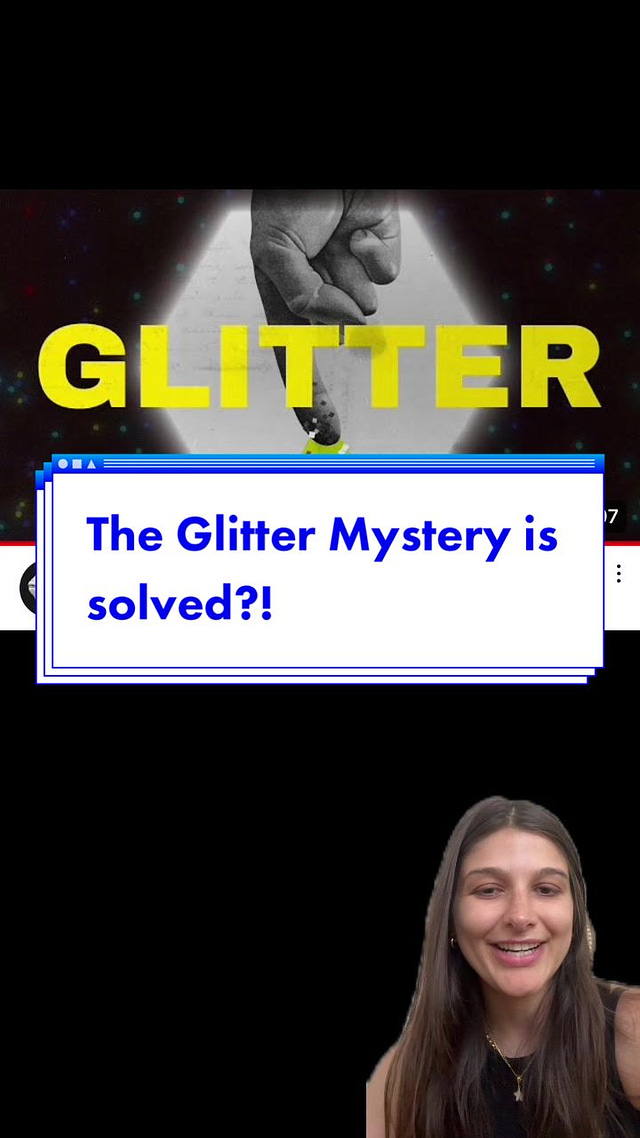
Kaylani worked in the PR industry for six years, but after she lost her job in a round of layoffs, she was inspired to try something new. She had been a longtime consumer of video essays, but no one in her IRL friend group was interested in them.
“They weren't anything that I could talk about with my friends or the people in my life,” she says over Zoom. “But every time I would watch these videos, I noticed that they would have hundreds of thousands of views, if not millions. So it was this feeling of like, ‘Okay, they're out there. People are watching these.’”
The Deep Dive has since gained over 6,500 subscribers since it launched in February of this year, and another nearly 57,000 follow it on TikTok. In this interview for paid subscribers, Kaylani and I talk about the video essay explosion, how TikTok is (ironically) boosting long-form content, and where people should get started if they, too, want to become video essay obsessives.
What’s the appeal of a video essay versus a written essay?
This post is for paid subscribers
- Sign Up / Log In
Create a free profile to get unlimited access to exclusive show news, updates, and more!
Watch Ryan Gosling's SNL Monologue and Sketches from April 13
The Fall Guy star's third turn hosting featured cameos from Kate McKinnon, Emily Blunt, and Caitlin Clark.

When Ryan Gosling 's third turn hosting Saturday Night Live started with a new installment of his "Close Encounters" sketches with Kate McKinnon , it was immediately clear that this would be a banger of an episode.
How to Watch
Watch Saturday Night Live Saturdays at 11:30/10:30c on NBC and next day on Peacock .
Gosling's monologue — which turned into a Barbenheimer musical number that doubled as promo for his new movie, The Fall Guy — was a showstopper that met the high bar he'd already set by the cold open. They subsequent sketches continued to deliver, with Gosling bringing the silly energy and full commitment to a bit that makes him such an excellent SNL Host.
RELATED: Watch the SNL Sketch That Inspired Greta Gerwig to Cast Ryan Gosling as Ken
Other highlights from the show included a sketch that found Gosling and Mikey Day as the human versions of Beavis and Butt-Head from the retro MTV cartoon of the same name (hats off to SNL 's costume and makeup departments!), and a country music video co-starring Musical Guest Chris Stapleton.
By the end of the night, we'd laughed even harder than Heidi Gardner did when she turned around to see Mikey Day in his Butt-Head costume.
Watch Ryan Gosling's Saturday Night Live sketches from April 13, below.
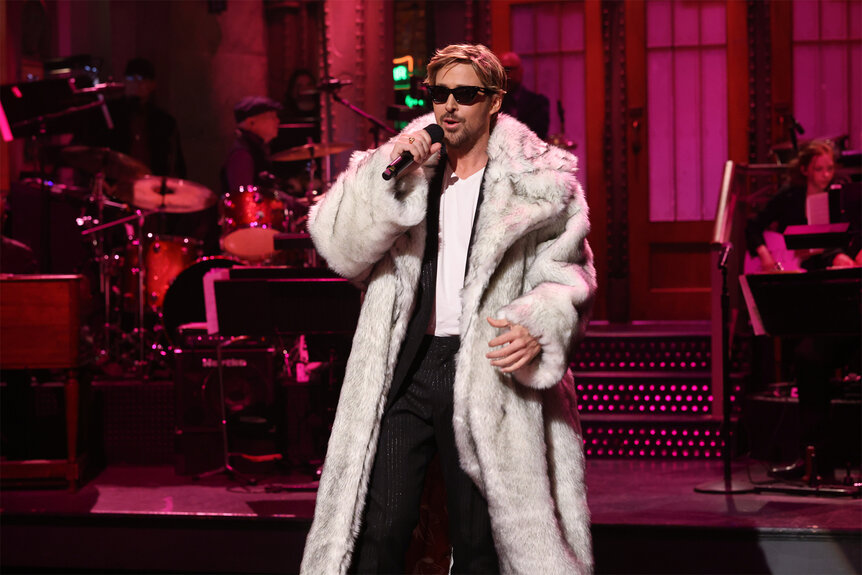
"Close Encounters" Cold Open
Watch above.
Gosling and McKinnon's recurring sketch, in which several alien abductees describe wildly differing experiences aboard the UFO, remained very funny due to its stars.
"Sir, before we begin, may I say something? I'm just realizing that I was wearing the same outfit the last time I was here," Gosling's "Close Encounters" character said at the top of the sketch, referring to the signature cap and retro quilted vest he's worn previously. "I just want you to know I do have other clothes."
Ryan Gosling's Monologue with Emily Blunt

A month after Ryan Gosling seemingly closed the door on his role in the Barbie movie with an amazing live performance of "I'm Just Ken," he had to squeeze in one more musical tribute to the doll, and launched into Taylor Swift's "All Too Well" (Ken's Version) with new Barbie -related lyrics.
Plans changed when he was joined by his The Fall Guy co-star Emily Blunt, and the pair teamed up for a Barbenheimer number complete with backup dancers and props.
The Engagement

Gosling played a desperate man named Harrison, who begged his new fiancée's friend Brad (Andrew Dismukes) to help him escape an engagement that he deeply regretted.
RELATED: Kristen Wiig's Pilates Movie Trailer Is a Chamber of Core-Strengthening Horrors

"Get That Boy Back" Featuring Chris Stapleton
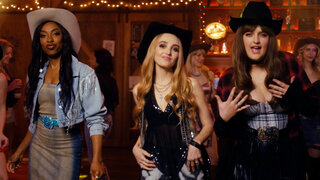
Freshman cast member Chloe Troast shone in this pre-taped musical sketch, a "Before He Cheats"-esque country bop in which three women (Troast, Chloe Fineman, and Ego Nwodim) sung of their plans to make their cheating men regret straying.
Stapleton was also great, playing the poor boyfriend/victim of some deranged revenge plans involving body paint.
Beavis and Butt-Head
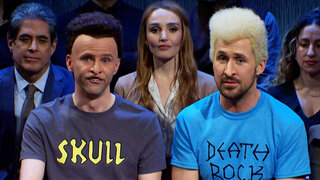
A TV news interview about the dangers of AI was disrupted by two men who look like one of those horrifying "what if this popular cartoon character was real?" AI memes. Gosling and Day were truly transformed into Mike Judge's animated metal heads.
Can't Tonight
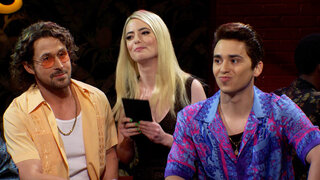
Three Latino men — well, two Latino men and an impressionable white guy (Gosling) who's in love with a Cuban woman — gathered ahead of what was going to be a wild night. (It was so wild that even "the original dog from Beethoven" would be there!)

A family grieved the sudden death of their grandfather, after hearing the news from the creepiest doctors ever (Bowen Yang and Ryan Gosling). This somehow led to the pair sharing a bag of crumpled cookie bits to delightful effect.
RELATED: Ryan Gosling and Jimmy Fallon Deserve Oscars for Playing Identical-Looking Tough Cops
Erin Brockovich
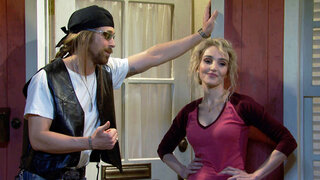
Chloe Fineman got to deliver Julia Roberts iconic monologue from the 2000 movie (Fineman officially loves referencing that era in film !), before Ryan Gosling performed a comeback monologue from Aaron Eckhart's character (Brockovich's boyfriend George) that definitely never happened.

In this callback to Gosling's September 30, 2017 show, Gosling's character from the original Papyrus sketch returned and was doing his best to heal from the laziness of the Avatar franchise's chosen font.
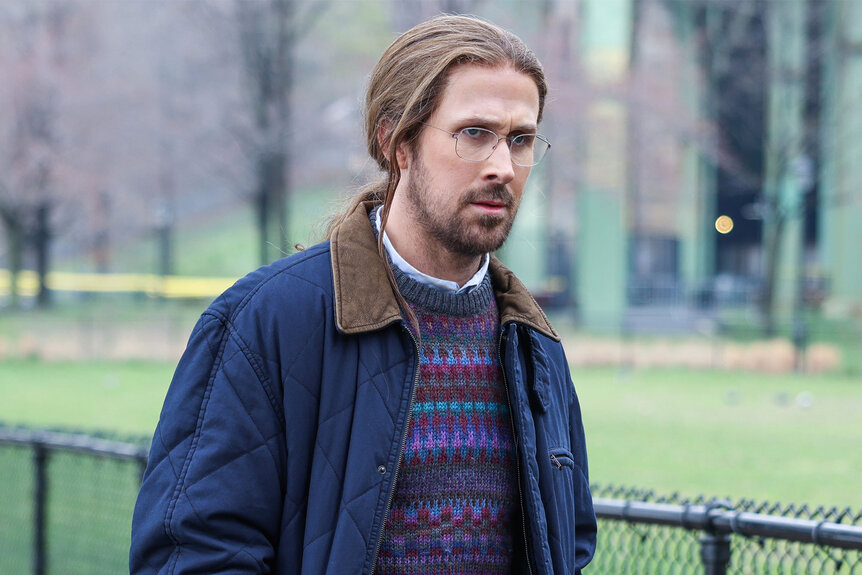
Saturday Night Live
- The Fall Guy
- Andrew Dismukes
- Chloe Fineman
- Chloe Troast
- Heidi Gardner
- Kenan Thompson
- Marcello Hernández
- Sarah Sherman
Related Stories
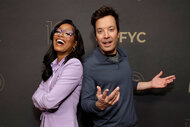
Jimmy Fallon and Keke Palmer Perform "Wild Thing" Live

Dua Lipa Is Saturday Night Live's May 4 Host and Musical Guest

Jimmy Fallon Talks Performing "Total Eclipse" with Heart

Chris Stapleton Crushed SNL's "Get That Boy Back" Sketch

Taylor Swift Approves of Ryan Gosling's "All Too Well" Cover on SNL

Ryan Gosling's Avatar Font-Hater Returns in "Papyrus 2"

Is Late Night with Seth Meyers New This Week?

Is The Tonight Show Starring Jimmy Fallon New This Week?

Caitlin Clark Roasted Michael Che on SNL's "Weekend Update"
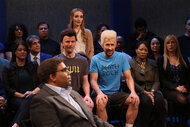
Ryan Gosling and Mikey Day As Beavis & Butt-Head on SNL

Ryan Gosling's SNL Episode Had a New "Close Encounter"
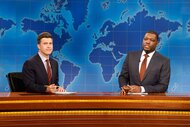
Watch Weekend Update From SNL Season 49 with Colin Jost and Michael Che
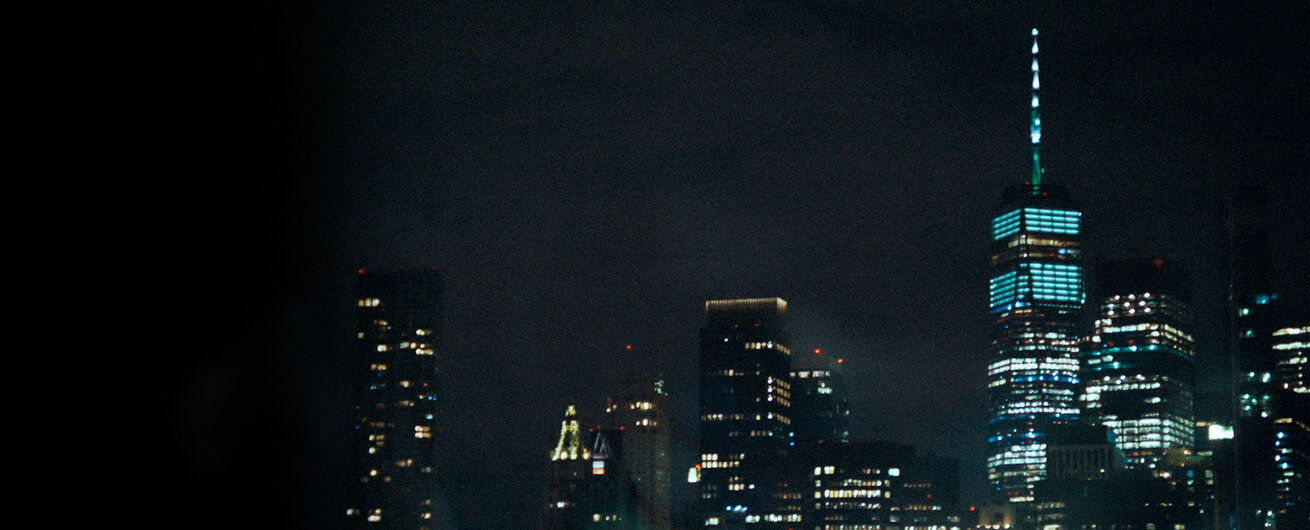
Recommended for You
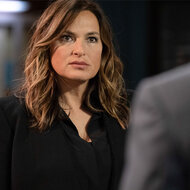
2-Year-Old Mariska Hargitay Appears on the Merv Griffin Show
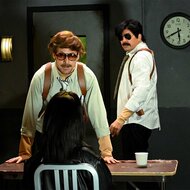
Ryan Gosling and Jimmy Fallon Deserve Oscars for Playing Identical-Looking Tough Cops

Scarlett Johansson Matches Katie Britt's SOTU Energy in SNL Parody: Watch
Advertisement
What Solar Eclipse-Gazing Has Looked Like for the Past 2 Centuries
Millions of people on Monday will continue the tradition of experiencing and capturing solar eclipses, a pursuit that has spawned a lot of unusual gear.
- Share full article

By Sarah Eckinger
- April 8, 2024
For centuries, people have been clamoring to glimpse solar eclipses. From astronomers with custom-built photographic equipment to groups huddled together with special glasses, this spectacle has captivated the human imagination.
Creating a Permanent Record
In 1860, Warren de la Rue captured what many sources describe as the first photograph of a total solar eclipse . He took it in Rivabellosa, Spain, with an instrument known as the Kew Photoheliograph . This combination of a telescope and camera was specifically built to photograph the sun.
Forty years later, Nevil Maskelyne, a magician and an astronomy enthusiast, filmed a total solar eclipse in North Carolina. The footage was lost, however, and only released in 2019 after it was rediscovered in the Royal Astronomical Society’s archives.

Telescopic Vision
For scientists and astronomers, eclipses provide an opportunity not only to view the moon’s umbra and gaze at the sun’s corona, but also to make observations that further their studies. Many observatories, or friendly neighbors with a telescope, also make their instruments available to the public during eclipses.
Fredrik Hjalmar Johansen, Fridtjof Nansen and Sigurd Scott Hansen observing a solar eclipse while on a polar expedition in 1894 .
Women from Wellesley College in Massachusetts and their professor tested out equipment ahead of their eclipse trip (to “catch old Sol in the act,” as the original New York Times article phrased it) to New London, Conn., in 1922.
A group from Swarthmore College in Pennsylvania traveled to Yerbaniz, Mexico, in 1923, with telescopes and a 65-foot camera to observe the sun’s corona .
Dr. J.J. Nassau, director of the Warner and Swasey Observatory at Case School of Applied Science in Cleveland, prepared to head to Douglas Hill, Maine, to study an eclipse in 1932. An entire freight car was required to transport the institution’s equipment.
Visitors viewed a solar eclipse at an observatory in Berlin in the mid-1930s.
A family set up two telescopes in Bar Harbor, Maine, in 1963. The two children placed stones on the base to help steady them.
An astronomer examined equipment for an eclipse in a desert in Mauritania in June 1973. We credit the hot climate for his choice in outfit.
Indirect Light
If you see people on Monday sprinting to your local park clutching pieces of paper, or with a cardboard box of their head, they are probably planning to reflect or project images of the solar eclipse onto a surface.
Cynthia Goulakos demonstrated a safe way to view a solar eclipse , with two pieces of cardboard to create a reflection of the shadowed sun, in Lowell, Mass., in 1970.
Another popular option is to create a pinhole camera. This woman did so in Central Park in 1963 by using a paper cup with a small hole in the bottom and a twin-lens reflex camera.
Amateur astronomers viewed a partial eclipse, projected from a telescope onto a screen, from atop the Empire State Building in 1967 .
Back in Central Park, in 1970, Irving Schwartz and his wife reflected an eclipse onto a piece of paper by holding binoculars on the edge of a garbage basket.
Children in Denver in 1979 used cardboard viewing boxes and pieces of paper with small pinholes to view projections of a partial eclipse.
A crowd gathered around a basin of water dyed with dark ink, waiting for the reflection of a solar eclipse to appear, in Hanoi, Vietnam, in 1995.
Staring at the Sun (or, How Not to Burn Your Retinas)
Eclipse-gazers have used different methods to protect their eyes throughout the years, some safer than others .
In 1927, women gathered at a window in a building in London to watch a total eclipse through smoked glass. This was popularized in France in the 1700s , but fell out of favor when physicians began writing papers on children whose vision was damaged.
Another trend was to use a strip of exposed photographic film, as seen below in Sydney, Australia, in 1948 and in Turkana, Kenya, in 1963. This method, which was even suggested by The Times in 1979 , has since been declared unsafe.
Solar eclipse glasses are a popular and safe way to view the event ( if you use models compliant with international safety standards ). Over the years there have been various styles, including these large hand-held options found in West Palm Beach, Fla., in 1979.
Parents and children watched a partial eclipse through their eclipse glasses in Tokyo in 1981.
Slimmer, more colorful options were used in Nabusimake, Colombia, in 1998.
In France in 1999.
And in Iran and England in 1999.
And the best way to see the eclipse? With family and friends at a watch party, like this one in Isalo National Park in Madagascar in 2001.
More From Forbes
‘fallout’ is amazing, though these five video game tv shows reviewed better.
- Share to Facebook
- Share to Twitter
- Share to Linkedin
The reception for Amazon Prime Video’s Fallout series has been stellar, racking up high critic scores and a ton of praise on social media. It’s a faithful adaptation of the world of the games while charting its own course, and is shaping up to be a big hit for Amazon with a likely season 2 on the way.
I’ve heard a lot of talk of some believing it’s the best video game adaptation ever made. Or at least better than one show perhaps, The Last of Us, HBO’s high profile, Emmy-winning adaptation of the Naughty Dog series. That’s subjective, of course (I tend to possibly agree? They’re great in different ways though). But I wanted to address this “video game curse” thing and remind everyone as great as Fallout is, there are actually four other game-based TV series in the modern era that have reviewed better. Here’s the list, along with some other shows that reviewed worse for context.
- Arcane – 100% critics, 96% audience
- Cyberpunk: Edgerunners – 100% critics, 95% audience
- The Last of Us – 96% critics, 89% audience
- Castlevania Nocturne – 96% critics, 45% audience
- Castlevania – 94% critics, 89% audience
- Fallout – 93% critics, 86% audience
- Dragon Age Absolution – 92% critics, 52% audience
- Dragon’s Dogma – 83% critics, 92% audience
- Halo – 80% critics, 61% audience
- Twisted Metal – 67% critics, 94% audience
- Resident Evil – 53% critics, 26% audience
It’s quite a range on that list, but as you can see, most modern video game adaptations, animated or live-action, have reviewed decently well with few exceptions. Even the second-lowest reviewed show on the list, Twisted Metal, was well-liked by fans and has gotten a second season.

Best Nintendo Switch Games: It’s Mario’s World, We’re Just Visiting
As for the top five, Arcane and Cyberpunk: Edgerunners are two of the only perfect 100% series to even exist on Netflix, especially with audience scores that are also that high (oh, and Ella Purnell from Fallout? She voiced Jynx in Arcane). The Last of Us is certainly the highest profile live action hit on this list, which is why it’s drawing these comparisons. I’d argue the original Castlevania animated series started this entire new era. And while I don’t dislike its Nocturne followup, I certainly don’t think it’s better than the original. Or Fallout. Or Twisted Metal. Fallout, interestingly, would be in seventh place on this list by audience score, which I find surprising.
Despite “fifth” place I am deeply impressed with Fallout because unlike The Last of Us, which is a good, but very grounded apocalyptic story, Fallout had to pull off action comedy on an entirely new level without source material to draw on, and it’s easy to see how maybe that could have hit with gamers but not general audiences. Instead, it seems to have hit with everyone. I look forward to a season 2 announcement in short order.
Follow me on Twitter , Threads , YouTube , and Instagram .
Pick up my sci-fi novels the Herokiller series and The Earthborn Trilogy .

- Editorial Standards
- Reprints & Permissions
- CBSSports.com
- Fanatics Sportsbook
- CBS Sports Home
- Champions League
- Motor Sports
- High School
- Horse Racing
Men's Brackets
Women's Brackets
Fantasy Baseball
Fantasy football, football pick'em, college pick'em, fantasy basketball, fantasy hockey, franchise games, 24/7 sports news network.
- CBS Sports Golazo Network
- PGA Tour on CBS
- UEFA Champions League
- UEFA Europa League
- Italian Serie A
- Watch CBS Sports Network
- TV Shows & Listings
The Early Edge
A Daily SportsLine Betting Podcast
With the First Pick
NFL Draft is coming up!
- Podcasts Home
- The First Cut Golf
- Beyond the Arc
- Eye On College Basketball
- NFL Pick Six
- Cover 3 College Football
- Fantasy Football Today
- My Teams Organize / See All Teams Help Account Settings Log Out
2024 Masters live stream, watch online: TV coverage, channel, Tiger Woods in Round 2, broadcast schedule
Watch every single shot from the biggest names in golf throughout round 1 at the 2024 masters.
AUGUSTA, Ga. -- The second day of action at the 2024 Masters is ongoing, and three days of pristine golf at the nation's best course remain with the best hoping to play all 72 holes at Augusta National. With clear skies, all competitors should be through 36 holes by day's end with the cut being made entering the weekend, though difficult-to-manage breezes have created tougher elements for some of the best golfers in the world Friday.
The grounds are filled to capacity with patrons, and they are undoubtedly keen to see how Tiger Woods plays while taking the course for just his second professional event of 2024. Woods is just five years removed from winning his fifth green jacket, and while a sixth is certainly unlikely, counting Tiger out of anything is a foolish endeavor. Woods has played solid golf as he nears the completion of his second round, and barring a collapse, should continue his made cuts streak at Augusta National.
Far more likely to find the winner's circle is Scottie Scheffler, the 2022 green jacket winner seeking to win his second in three years. Scheffler entered as an overwhelming favorite and sat +140 to win the tournament entering Friday one back of Day 1-leader Bryson DeChambeau . Rory McIlroy, of course, is still one Masters title away from clinching the career grand slam, and he ended Thursday under par through 18 holes at Augusta National for the first time in six years.
Max Homa is seeking his first major championship, and a run Friday morning has boosted him near the top of the leaderboard with a chance to contend entering the weekend. You can follow Masters leaderboard updates and coverage all day right here on CBSSports.com.
There is so much to pay attention to this week that it can be overwhelming at times. No worries: We have you covered. On Friday alone, you can watch the entire first rounds from Woods, Scheffler, McIlroy, DeChambeau, Xander Schauffele, Jordan Spieth and others.
CBS Sports is offering live coverage of the 2024 Masters from start to finish Friday with our myriad of Masters Live streaming options. Hit the links below to tune into the Featured Groups channel and watch complete rounds from some of the best golfers in the game, spend your day surveying Amen Corner or view all the action at Holes 15 & 16. Masters TV coverage does not begin until later in the day, so this is the absolute best place to watch the Masters live on Friday.
All times Eastern
Round 2 -- Friday, April 12
Round 2 start time: 8 a.m.
Masters Live stream Desktop and mobile: Free on CBSSports.com , CBS Sports app Connected devices*: Available on Paramount+ , CBS Sports app *Paramount+ login required
- Masters on the Range : 8:30-10:30 a.m. (CBS Sports Network, Paramount+ )
- Featured Groups -- 10:15 a.m. to 7:30 p.m. 10:18 a.m. -- Tiger Woods, Jason Day, Max Homa 10:42 a.m. -- Jordan Spieth, Ludvig Åberg, Sahith Theegala 11:54 a.m. -- Gary Woodland, Thorbjørn Olesen, Bryson DeChambeau 1:48 p.m. -- Scottie Scheffler, Rory McIlroy, Xander Schauffele
- Amen Corner -- 10:30 a.m. to 6 p.m.
- Holes 15 & 16 -- 11:30 a.m. to 7 p.m.
- Holes 4, 5 & 6 -- 8:45 a.m. to 3:30 p.m. (Masters.com)
TV coverage: 3-7:30 p.m. on ESPN TV simulcast live stream: 3-7:30 p.m. on Masters.com Post-round highlights: 11:35-11:50 p.m. on CBS, Paramount+
Our Latest Golf Stories
2024 RBC Heritage odds, picks, best bets, field
Cbs sports staff • 5 min read.
2024 RBC Heritage odds, expert picks, best bets
Cbs sports staff • 3 min read.
2024 RBC Heritage One and Done expert picks, sleepers
Cbs sports staff • 4 min read.
2024 RBC Heritage PGA DFS picks, lineups, strategy
Rory McIlroy emphatically shuts down LIV Golf rumors
Patrick mcdonald • 2 min read.
2024 RBC Heritage preview, picks, predictions
Patrick mcdonald • 5 min read, share video.

How to watch 2024 Masters Live on Friday

Faith, focus make Scheffler unshakable

Åberg's trajectory among final thoughts

2024 Masters prize money, $20M payout breakdown
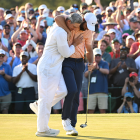
Scheffler wins Masters despite wife's rare absence

Tiger ends 100th Masters with worst major score

Spieth, J.T. among stars to miss the cut at Masters

Davis Love III enthused about golf's young stars
/cdn.vox-cdn.com/uploads/chorus_image/image/62748567/la_et_mn_the_hobbit_finale_new_title_the_battl_001.0.jpg)
Filed under:
The best video essays of 2018
From scene breakdowns to ideological deconstructions, selections from YouTube’s sharpest voices
Share this story
- Share this on Facebook
- Share this on Reddit
- Share All sharing options
Share All sharing options for: The best video essays of 2018
Anyone who clocks serious time on YouTube knows it’s a full-blown cosmos, housing everything from Vine compilations to weird algorithm-generated kids videos and fascists talking about phrenology. But the site also hosts a strong crop of creators engaging with politics, philosophy, culture, and more in thoughtful, critical ways.
Video essays have flourished in recent times, and the best ones can even eclipse a lot of traditional documentaries in their production and intelligence. On top of recommending Polygon’s own staff of video craftspeople , here are 10 of the best video essays of 2018, a shortcut down the rabbit hole of intriguing work on YouTube.
“David Lynch: The Treachery of Language”
By What’s So Great About That?
This is simply the most well-made, intelligently laid-out video on a single filmmaker this year. Through some masterful editing, Grace Lee explores the use (or more accurately, consistent warping) of language in the films of David Lynch ( Mulholland Drive , Blue Velvet , TV’s Twin Peaks ). Film criticism generally gravitates toward discussion of visuals, whether that’s in terms of cinematography, editing, acting, mise-en-scene , and the like. The actual construction and implementation of dialogue is less studied, and by drilling down into the specific use, Lee’s video gets at a defining element of why Lynch’s films are so off.
“CTRL+ALT+DEL”
By hbomberguy
Taking on one of the biggest punching bags in both webcomics and gaming is no small task, but H. Bomberguy proves more than up to it. But rather than make yet another piece on all the ways Tim Buckley’s Ctrl+Alt+Del is supposedly terrible, the video essayist instead draws out all the ways it’s similar to popular, even beloved, properties. The unsettling conclusion is that works like these become whipping boys not because of their actual quality (or lack of it), but because they provide a reflection that too many within a subculture find unflattering. That it’s all delivered via an increasingly unhinged parody of traditional YouTube critic tropes is a huge bonus.
The Hobbit Trilogy
By Lindsay Ellis
Lindsay Ellis defies the paradigm of movie criticism through nuanced, researched nitpicking. Her in-depth series on Hobbit films goes beyond a dismantlement, instead connecting the dots between what happened during the series’ production, Peter Jackson’s entire approach to the adaptation, and by her estimation, the film’s critical failures. The third part of the “duology” even incorporates reporting, with Ellis talking to actors and filmmakers in New Zealand about the effect that foreign film production had on the country. It all culminates in a powerful rumination on how “no ethical consumption under capitalism” applies to entertainment, and the different ways people grapple after learning how beloved art was made.
“Designing for Disability”
By Game Maker’s Toolkit
Mark Brown is one of the most measured and meticulous people working in games criticism today. As the name of the channel suggests, Game Maker’s Toolkit approaches video game analysis from the angle of helping developers improve their work. Any one of his videos is invaluable on this front, and this ongoing series about keeping differently abled people in mind when making games is a great showcase of his perspective. Besides providing a survey of what games already do to accommodate players who can’t necessarily interact with them in the standard ways, these videos subtly call attention to how so much of the basic ways in which we interact with games are taken for granted.
“Lady Eboshi is Wrong”
By Innuendo Studios
If this were just a video on how masterful Hayao Miyazaki is at making movies without clear good-and-evil conflicts, in which no character is two-dimensional and everyone’s point of view is expressed, then it would be notable. But what pushes the essay (made for FilmJoy’s “Lessons Animation Taught Us” series) into greatness is how uses Princess Mononoke ’s central conflict to basically pick apart the idea of centrism as a political position. Ian Danskin knows culture and politics; he also happens to be producing an incisive series on the rhetorical foundations and strategies of the far right. Wielding the knowledge, the essayist finds echoes of the man-vs-nature peril at the heart of Miyazaki’s period fantasy to today’s current political climate without being so blunt as to become an entirely different type of video.
“FAKE FRIENDS EPISODE TWO: parasocial hell”
By StrucciMovies
You may balk at the two-hour running time, but Shannon Strucci more than earns the runtime as she exhaustively dissects the social landscape of the modern age. The second part of her ongoing series on parasocial relationships (when a person develops a “relationship” with someone or something that cannot reciprocate, like a celebrity) continually finds new stories to develop its ideas.
Strucci will let a clip of a Twitch streamer making an emotional confession play out in full length, all to hammer home the kind of closeness the internet fosters between people with no actual connection. She also brings up examples one might not expect, such as a robotic seal doll made to calm the elderly, or the famous story of Grape-kun , the penguin who fell in love with an anime standee. “Fake Friends” will make you reconsider your own relationships with your favorite writers, podcasters, actors… and possibly video essayists.
By ContraPoints
Natalie Wynn, who dropped out of Northwestern’s Ph.D philosophy program and now applies her knowledge to the headache of contemporary American discourse, specializes in responding to talking points from modern conservatism. It helps that, besides being smart as hell, she also employs some extraordinarily elaborate costuming and spectacular (usually horny) punchlines into her work. In her most impressive video to date, it would be all too easy to go for easy jabs at those who identify as incels, but Wynn approaches the subject with empathy without ever making excuses for their toxic rhetoric.
“DOOM: The Fake Outrage”
Shaun is quite possibly the most droll human on the internet, and has carved out a niche in poking holes in the hole-poking antics of channels like CinemaSins. Here, he demonstrates the common internet strategy of cherry-picking a few tweets or comments to trump up a non-issue like “The SJWs are angry.”
“Disney - The Magic of Animation”
By kaptainkristian
There was much rejoicing with Kristian Williams returned to YouTube after a year’s hiatus, and his first new video proved well worth the wait. Disney is a tremendously popular subject for video essays, and there are plenty about the studio’s revered 12 principles of animation. But none of them tackle the subject with the visual and editing skill that Williams brings to the table.
“Nostalghia Critique”
by KyleKallgrenBHH
This essay is simultaneously and seamlessly many things: an exegesis on a single scene in Andrei Tarkovsky’s 1983 film Nostalghia , playing it without any cuts; a look at how video creators work around content copyright rules with various editing and presentational tricks; and a meditation on creator Kyle Kallgren’s time with a company that frequently struggled with the strictures of YouTube’s copyright rules, and how it eventually fell apart under the malfeasance of the people running it. “Nostalghia Critique” is an unshowy but wonderful union of personal, aesthetic, and corporate concerns.
Dan Schindel is an editor, writer, and critic based in Los Angeles.
Billy Joel's 100th residency special cut during pivotal 'Piano Man' performance, CBS apologizes

CBS did not turn the lights back on during the 100th show of Billy Joel's residency .
The network in a statement on Monday apologized for ending the singer's "Billy Joel: The 100th – Live at Madison Square Garden" special two minutes early on Sunday, blaming a "network programming timing error." CBS also said it will rebroadcast the two-hour special on Friday at 9 p.m. ET.
"We apologize to Mr. Joel, his fans, our affiliated stations, and our audience whose viewing experience was interrupted during the last song," CBS said in a statement to USA TODAY Monday.
The special marked the centennial of Joel's record-setting run at Madison Square Garden , which began in January 2014 and will conclude July 25.
Excited fans who tuned in were upset after the broadcast was delayed by 30 minutes due to the 2024 Masters Tournament and ultimately cut off in the middle of Joel's larger than life "Piano Man" for local news programming.
The Barstool Sports account chimed into the discourse on X, formerly Twitter, writing , "How do you cut a Billy Joel Concert in the Middle of Piano Man?!"
"CBS has been promoting the Billy Joel concert special every two minutes for WEEKS. So what better way to air it than to preempt it for a half hour and the cut him off MID-PIANO MAN? C'mon guys," one upset fan posted .
Another wrote , "You couldn't produce a worse product than CBS just did on the Billy Joel special Way too many commercials, didn't play some of his best songs, went extremely out of order in his set list, and then cuts away to the local news in the middle of Piano Man?!? A total flop by CBS."
"Just an absolute disaster by CBS tonight producing the Billy Joel concert. Ineptitude at its finest. Start it late and cut it off early. Just horrible. #BillyJoel100," another dissatisfied viewer posted .
Billy Joel releases new song 'Turn the Lights Back On' ahead of Grammy Awards performance
Where to watch Billy Joel concert special
Joel's special is available to stream on Paramount+ for those that didn't get the full experience.
Billy Joel was happy to 'hang out' with Taylor Swift and Ed Sheeran, talks 100th MSG show
In an interview with USA TODAY , the "Uptown Girl" singer said the 100th performance, including appearances from pals Jerry Seinfeld and Sting, was different from the earlier shows "because there were a bunch of cameras on stage!"
"I've been playing (Madison Square Garden) since the '70s. The 100 just happened to be a round number and happened to coincide with a Garden show I was already doing," he said.
When it came to including Sting in this particular show, Joel said, "I've known him quite a while, since he was in The Police. We became friends right away and I always admired his musicianship. We respect each other as musicians. It's very easy for me to work with him. It doesn't require a long rehearsal process. I hate rehearsal."
"I'm OK with making a mistake. A lot of the fun of it is in the spontaneity of the recovery," he added. "He and I have great bands, and if you're working with good musicians it makes life so much easier. I've written songs with Sting in mind, like 'Big Man on Mulberry Street,' which we do in this show."
Contributing: Melissa Ruggieri , Brendan Morrow
VIDEO: Watch as hidden ball trick secures victory for Delsea baseball team
- Updated: Apr. 14, 2024, 9:07 p.m. |
- Published: Apr. 14, 2024, 8:08 a.m.
- Kevin Minnick | NJ Advance Media for NJ.com
What a way to end a baseball game.
Clinging to a one-run lead in the top of the seventh inning Saturday, Delsea coach Joe Smith pulled a game-ending play out of his bag of tricks.
With a runner on second base, pitcher George Starr stepped off the rubber and faked a pickoff attempt. Teammates executed the play to perfection, with everyone buying into the ball sailing into center field.
The base runner initially dove back to the bag, but then got up and started to make his way to third. Starr raced over, tagged him out and a 4-3 victory over Audubon was sealed.
“I don’t even know what to say. We were just trying to get a win against one of the best coaches and programs in South Jersey,” Smith said.
Smith tried the same play in the season opener against Cumberland and it failed.
A video clip of the game went viral, ending up on ESPN’s SportsCenter as one of “Saturday’s Best.”
Check out the sequence of events below.
Kids sold it perfectly pic.twitter.com/paEfoVaFNC — Joe Smith (@gr3champs) April 13, 2024
The N.J. High School Sports newsletter now appearing in mailboxes 5 days a week. Sign up now and be among the first to get all the boys and girls sports you care about, straight to your inbox each weekday. To add your name, click here .
Thank you for relying on us to provide the journalism you can trust. Please consider supporting NJ.com with a subscription.
Kevin Minnick covers South Jersey baseball. He can be reached at [email protected] . Follow him on X (formerly Twitter) @kminnicksports
If you purchase a product or register for an account through a link on our site, we may receive compensation. By using this site, you consent to our User Agreement and agree that your clicks, interactions, and personal information may be collected, recorded, and/or stored by us and social media and other third-party partners in accordance with our Privacy Policy.

IMAGES
VIDEO
COMMENTS
As Olson points out, "In Search of Flat Earth" could have an alternative clickbait title of "The Twist at 37 Minutes Will Make You Believe We Live In Hell.". Over the years, Dan Olson of ...
The best video essays of 2021. An escape from the most popular to the most captivating. By Ransford James and Wil Williams Dec 29, 2021, 2:00pm EST. Illustration: Ariel Davis for Polygon. As ...
Part of Polygon's Best of the Year 2023. Looking at the year's notable video essays, many grapple with issues at the heart of contemporary media itself. There are dissections of video-playing ...
Deconstructing the Bridge by Total Refusal. This is perhaps the least "essay-like" video on this list. It's more of a university-level lecture, but set in the least academic forum imaginable ...
The best video essays of 2023. Our annual poll spotlights 181 unique video essays, nominated by 48 international voters, showcasing the breadth and depth of current videographic practice. 19 December 2023. By Queline Meadows, Irina Trocan, Will Webb. A History of the World According to Getty Images (2022)
The best video essays of 2021. Introspection and the act of watching emerged as recurring themes across a year in which video makers responded to the realities of a continuing pandemic. Our poll of 30 video essayists, academics, critics and filmmakers highlights 120 recommendations. 18 January 2022. By Ariel Avissar, Cydnii Wilde Harris, Grace Lee.
The 2022 video essay retrospective was compiled with the help of 44 voters (from 21 countries) for the 'Best of' or 'Emerging voices' sections. The contributors bring in their expertise as video essayists (several of whom earned nominations in the poll from their peers), film/art critics, film-studies academics (professors, researchers) and festival curators, collectively building a ...
But, for now, let's take a look back on the best video essays of 2021: Why 4:3 Looks So Good. Sneak Peek. For a significant period of both film and television history, the boxy 4:3 aspect ratio ...
Watch here. Be sure to watch the Essay Library Anthology's sixth volume, ... "Curating Sight & Sound 's Best Video Essays of 2023." In a conversation moderated by Kevin B. Lee, the curators of this year's list discuss the results of the poll, their curatorial strategies, and offer general thoughts on the video essay landscape in 2023. ...
Essay By. This video on the incredible Disney sequel The Lion King 1 ½ is by Jace, a.k.a BREADSWORD, an LA-based video essayist who specializes in long-form nostalgia-heavy love letters ...
As Olson points out, "In Search of Flat Earth" could have an alternative clickbait title of "The Twist at 37 Minutes Will Make You Believe We Live In Hell.". Over the years, Dan Olson of ...
A video essay is a video that analyzes a specific topic, theme, person or thesis. Because video essays are a rather new form, they can be difficult to define, but recognizable nonetheless. To put it simply, they are essays in video form that aim to persuade, educate, or critique. These essays have become increasingly popular within the era of ...
UK creator and pop-culture academic Grace Lee makes video essays examining themes and form in both horror and animated media; she has an affinity for the deeper, more unexpected thoughts evoked by ...
The video essay boom. Hour-long YouTube videos are thriving in the TikTok era. Their popularity reflects our desire for more nuanced content online. By Terry Nguyen Mar 9, 2022, 8:00am EST. Video ...
With so many to sort through, here are some recommendations for the best recent video essays to check out. "Art in the Pre-Apocalypse" (screenshot by Dan Schindel/Hyperallergic)" Since ...
Life is Strange 2 is an episodic video game developed by DONTИOD Entertainment and published by Square Enix for PC, PlayStation, Xbox and Nintendo Switch. "Two brothers Sean and Daniel Diaz, 16 and 9, are forced to run away from home after a tragic incident in Seattle. In fear of the police, Sean & Daniel head to Mexico while attempting to ...
4. "CATS! And the Weird Mind of TS Eliot," Maggie Mae Fish. The Baffling Politics of Cats (2019) and TS Eliot. Cats may have come out in 2019, but Maggie Mae Fish's video essay on it came ...
A year of physical separation and isolation was, not coincidentally, a year of unprecedented outreach and collaboration amongst the artists, critics and scholars at work in the burgeoning form of the video essay. Our poll of 42 of those essayists highlights 170 recommendations. 26 December 2020. By Ariel Avissar, Cydnii Wilde Harris, Grace Lee.
kate lindsay. ·. November 16, 2022. Read full story. Kaylani writes The Deep Dive, a newsletter in which she curates five video essay recommendations every week, although I discovered her on TikTok, where her videos highlighting recent stand-out essays have received millions of views of their own.
Some of the best video essays on YouTube. Most of them are about film but some of them aren't. You should probably watch them. That is if you feel like it.
RELATED: Watch the SNL Sketch That Inspired Greta Gerwig to Cast Ryan Gosling as Ken. Watch Ryan Gosling's Saturday Night Live sketches from April 13 below. Ryan Gosling during Promos for Saturday ...
What Solar Eclipse-Gazing Has Looked Like for the Past 2 Centuries. Millions of people on Monday will continue the tradition of experiencing and capturing solar eclipses, a pursuit that has ...
Dan Olson of Folding Ideas has been creating phenomenal video essays for years. Highlighting "In Search of Flat Earth" as one of the best video essays in 2020 (and, honestly, ever) gives an ...
Some of my favorite video essays on his website. Most of these are about video games. A little less of them are about movies or TV shows. A little less of th...
Here's the list, along with some other shows that reviewed worse for context. Arcane - 100% critics, 96% audience. Cyberpunk: Edgerunners - 100% critics, 95% audience. The Last of Us - 96% ...
Masters TV coverage does not begin until later in the day, so this is the absolute best place to watch the Masters live on Friday. All times Eastern. Round 2 -- Friday, April 12. Round 2 start ...
Here are tips from the U.S. space agency: Pick an area well away from city lights or street lights. Bring a sleeping bag, blanket, or lawn chair. Lie flat on your back with your feet facing east ...
Video essays have flourished in recent times, and the best ones can even eclipse a lot of traditional documentaries in their production and intelligence. On top of recommending Polygon's own ...
CBS did not turn the lights back on during the 100th show of Billy Joel's residency. The network marked the centennial of his record-setting run at Madison Square Garden, which began in January ...
Clinging to a one-run lead in the top of the seventh inning Saturday, Delsea coach Joe Smith pulled a game-ending play out of his bag of tricks. With a runner on second base, pitcher George Starr ...